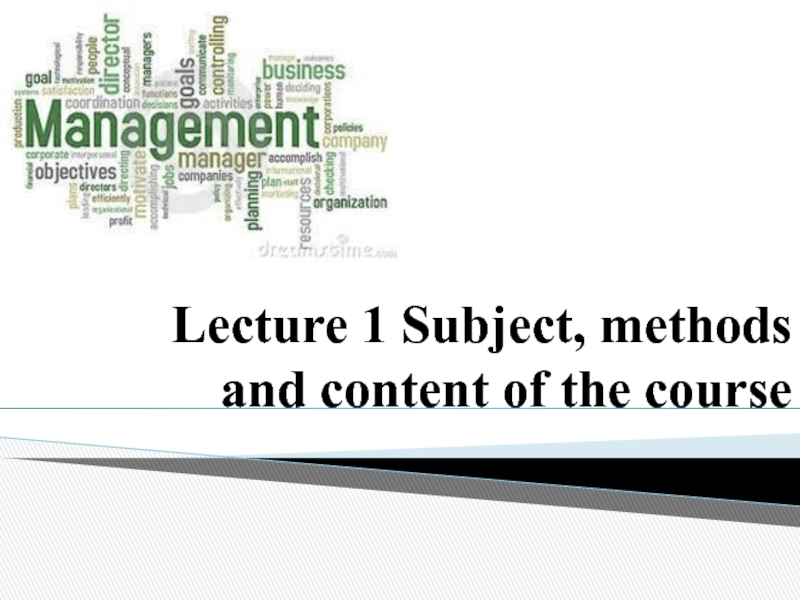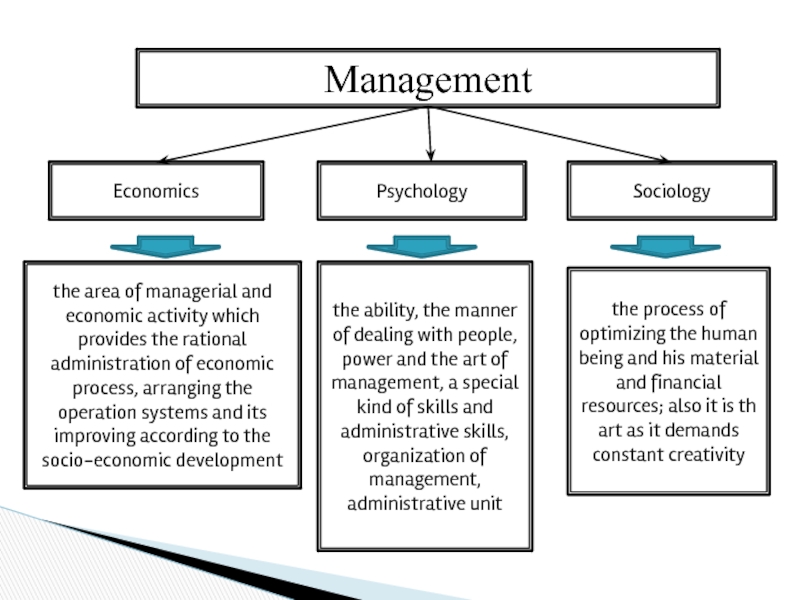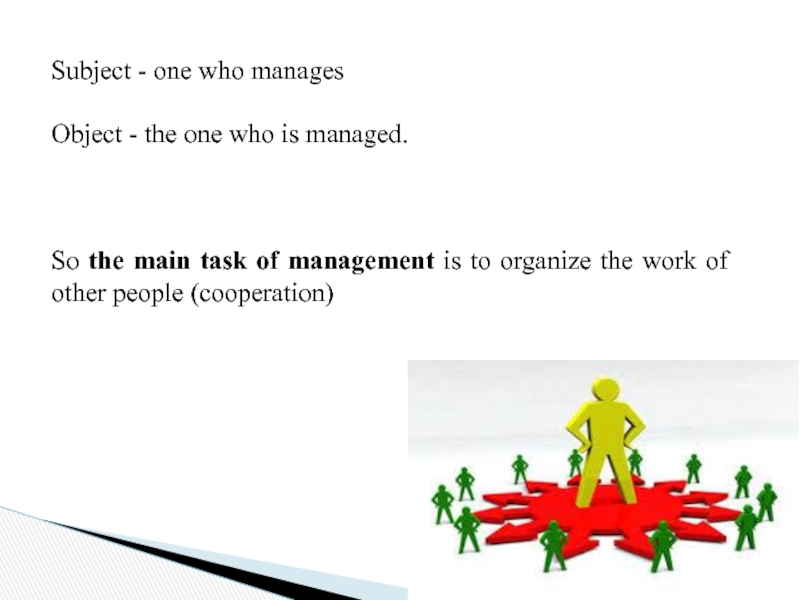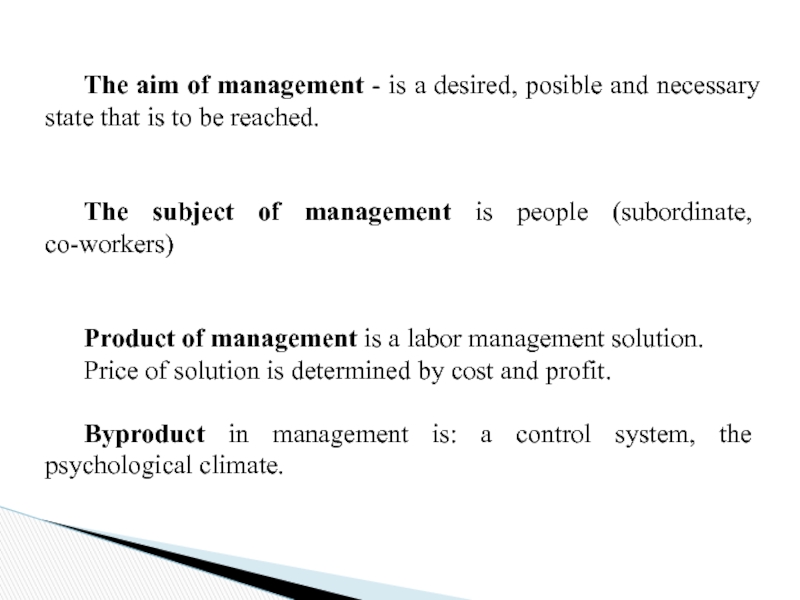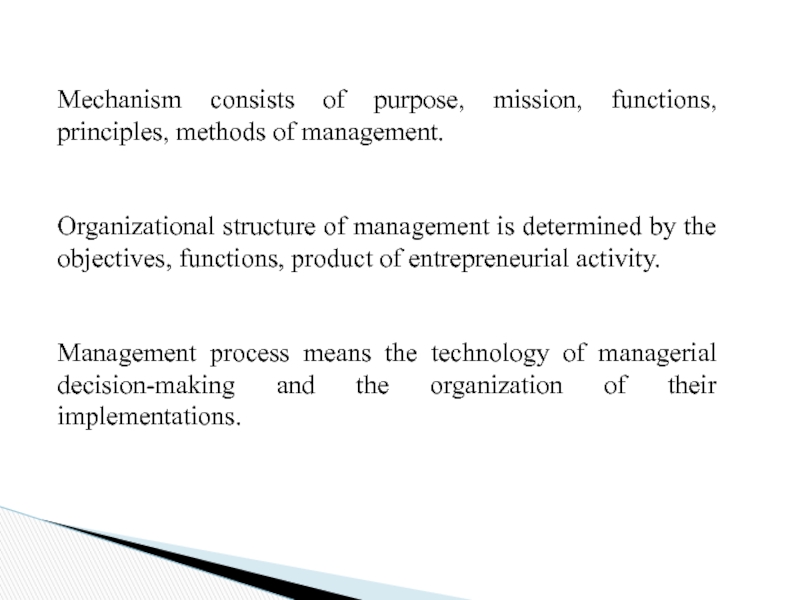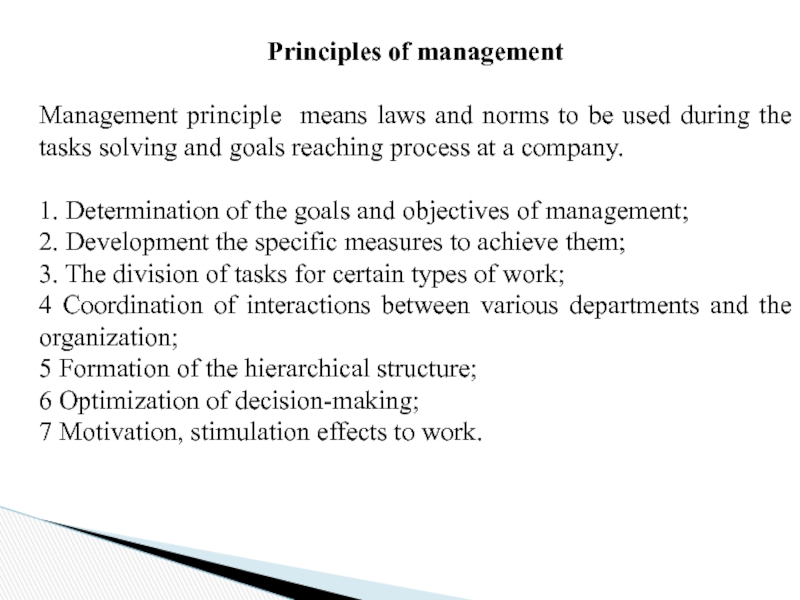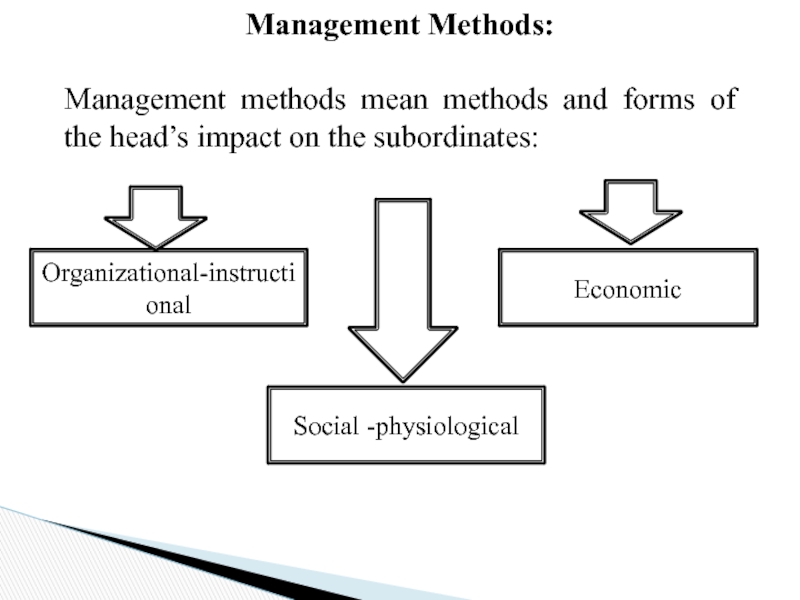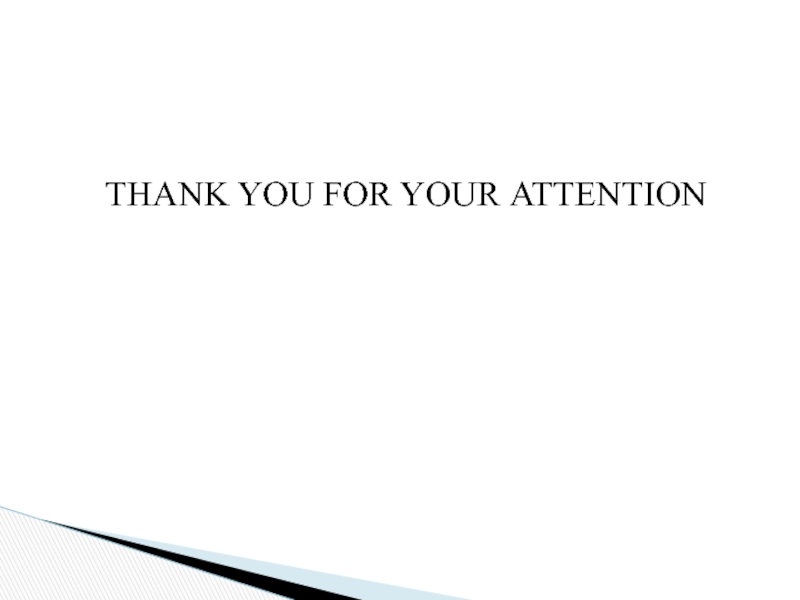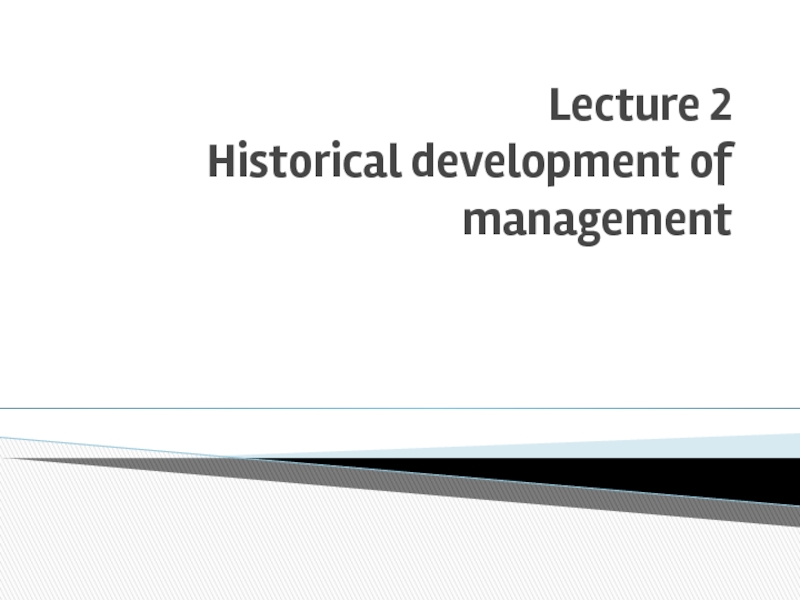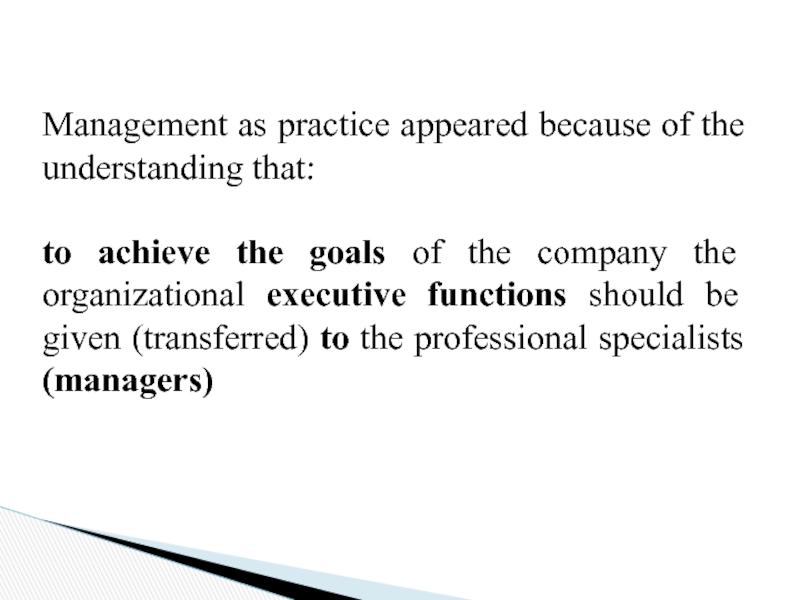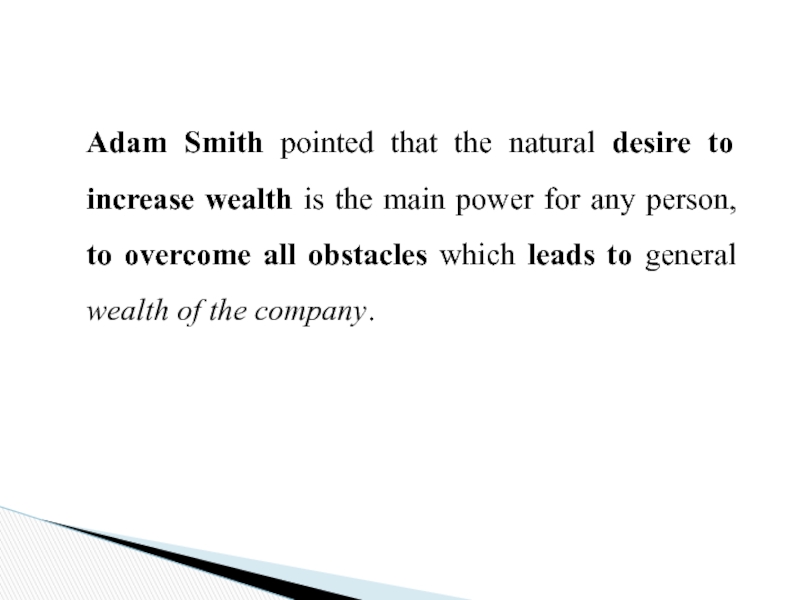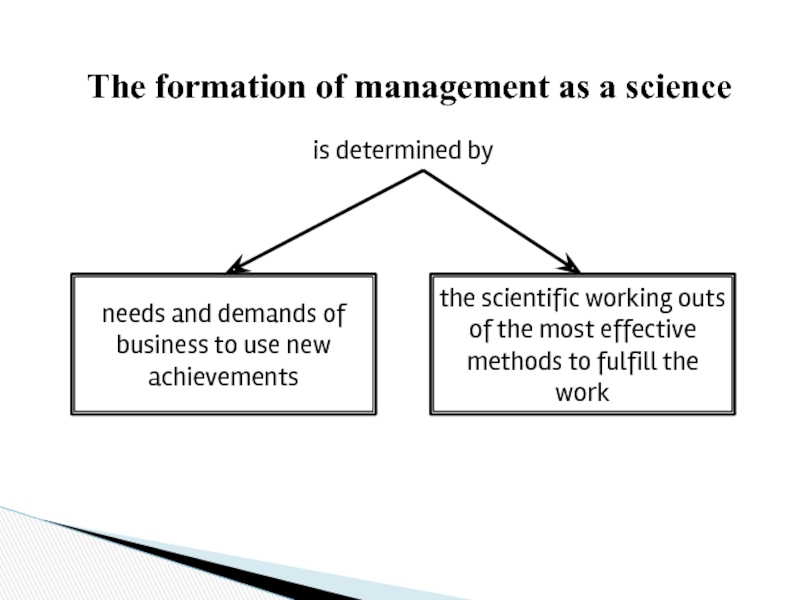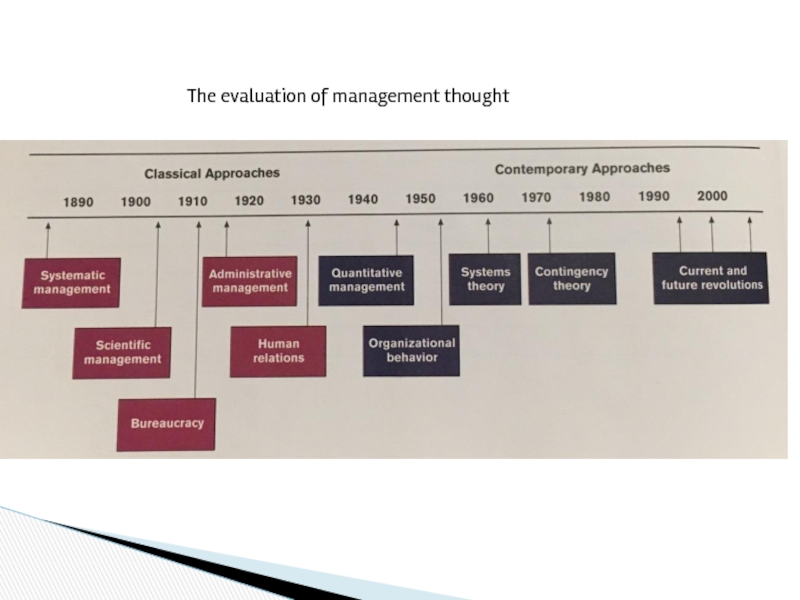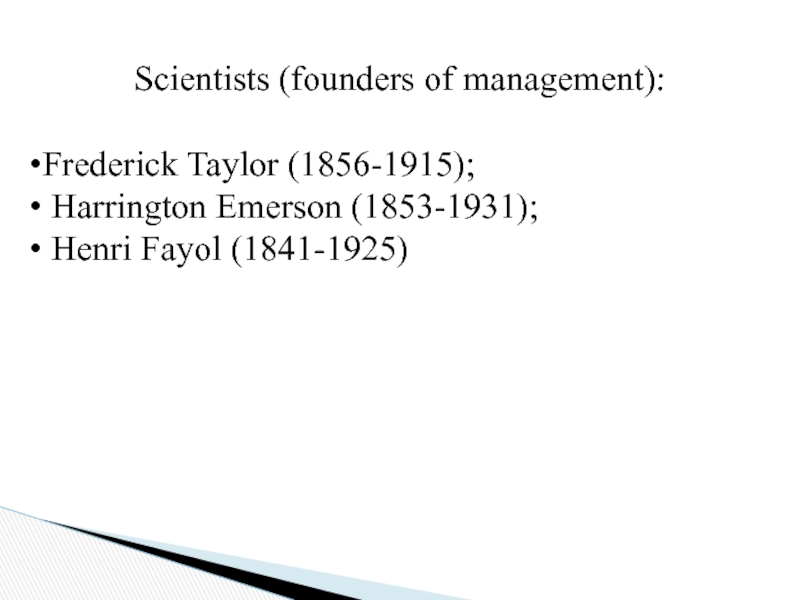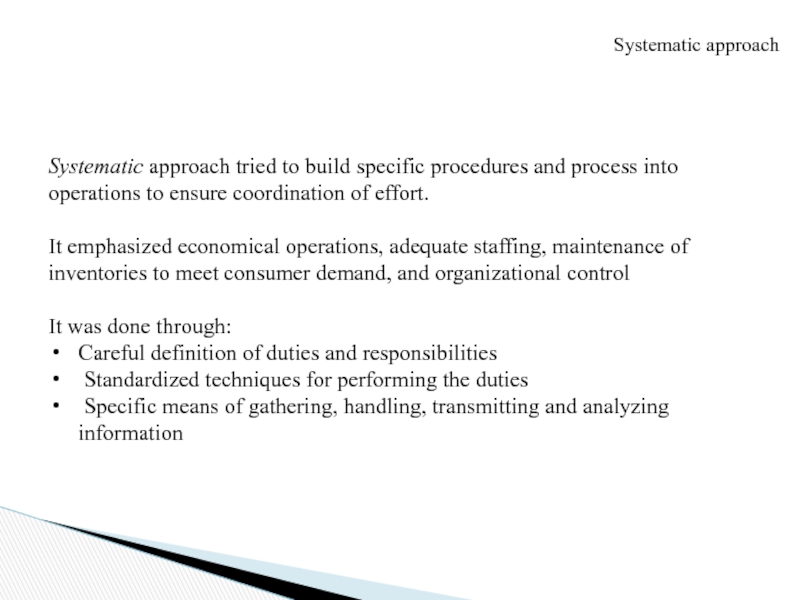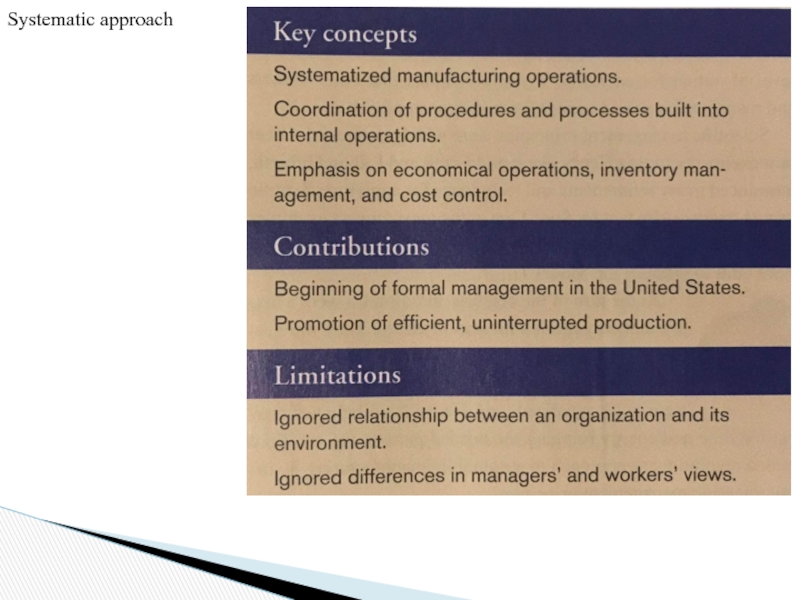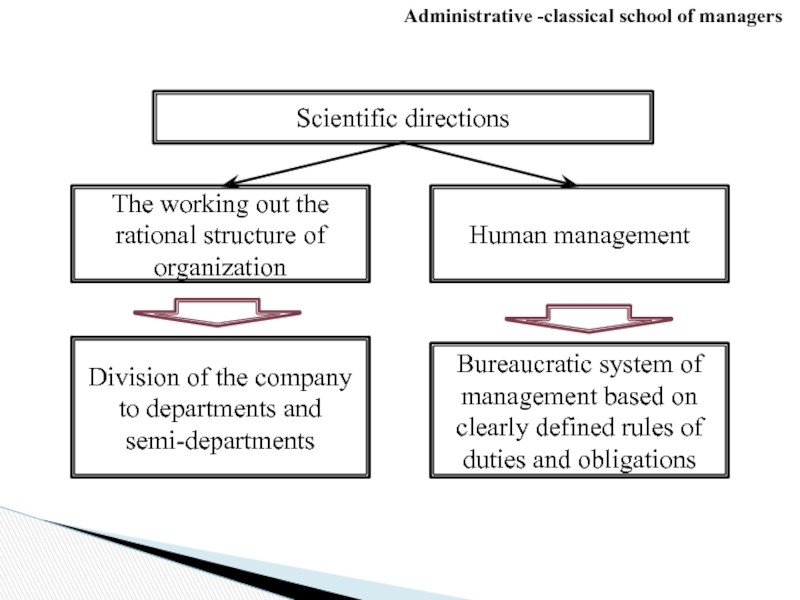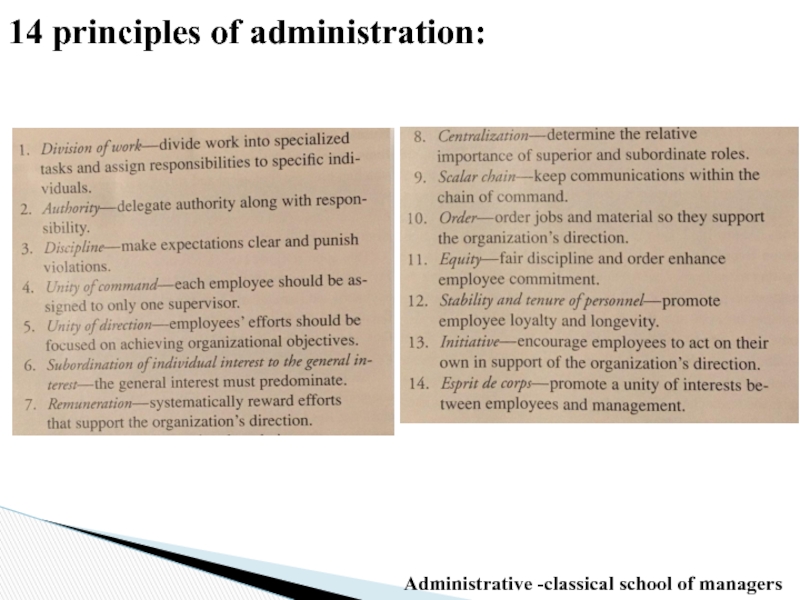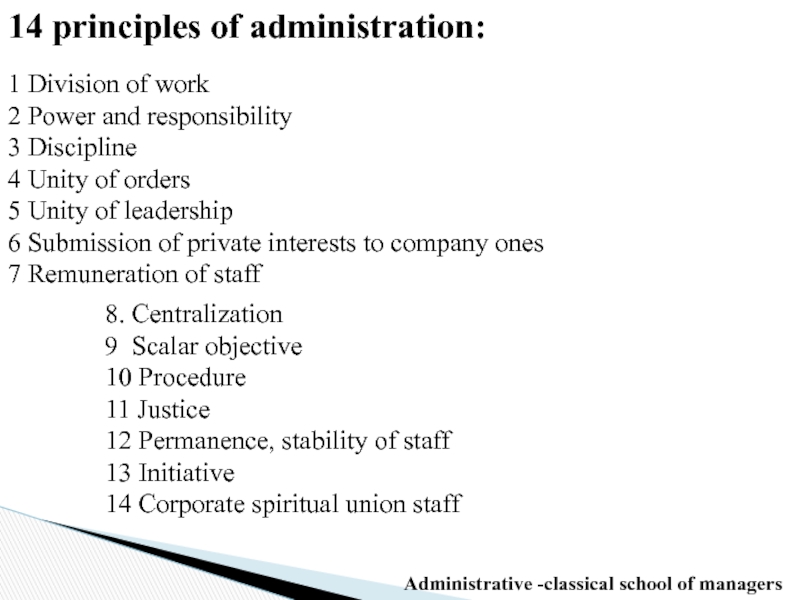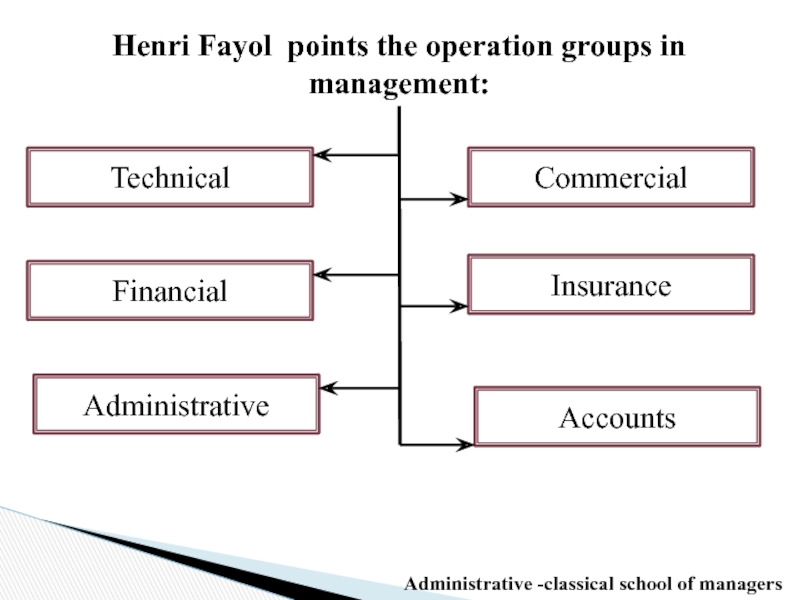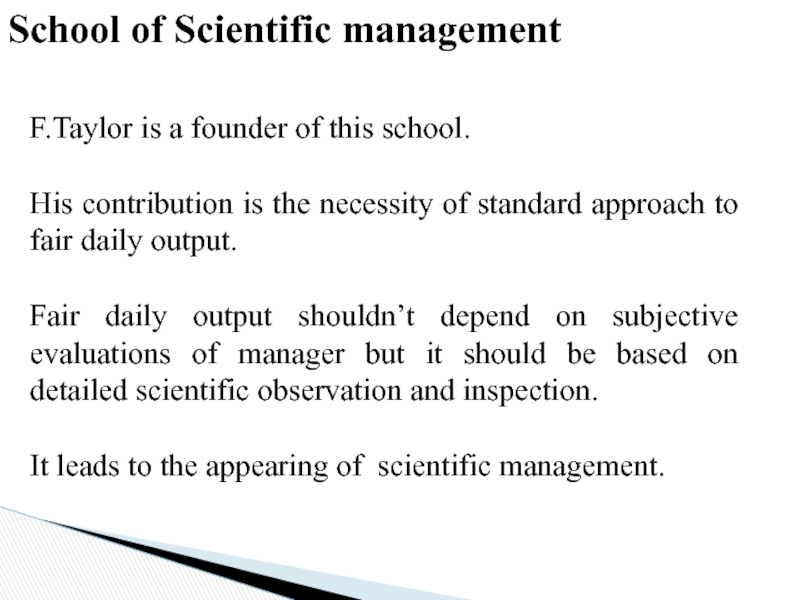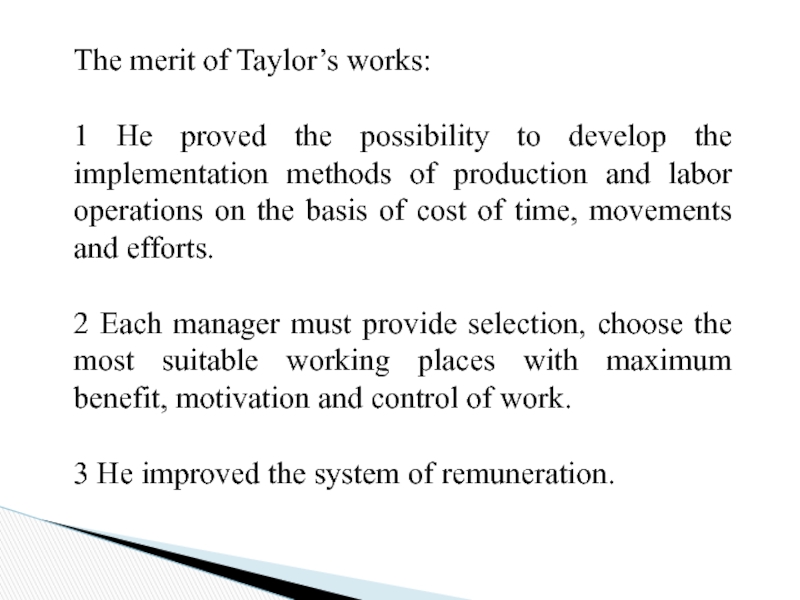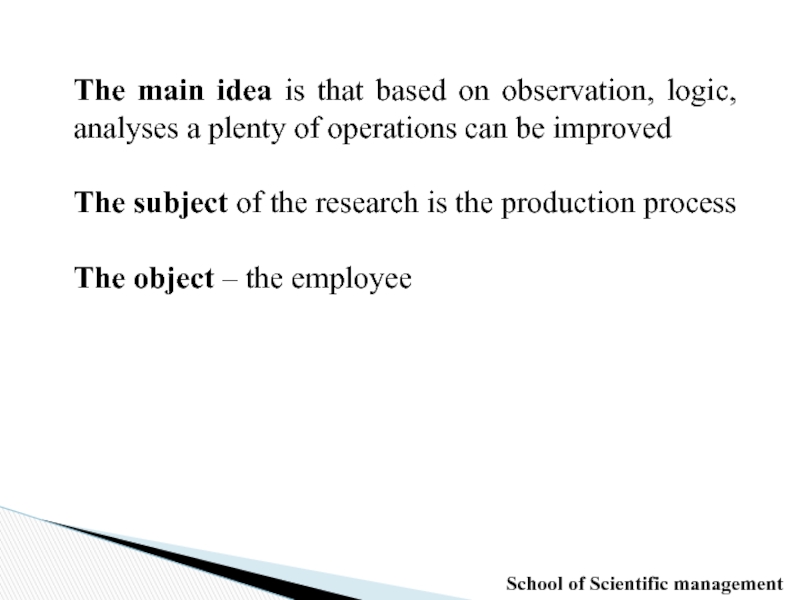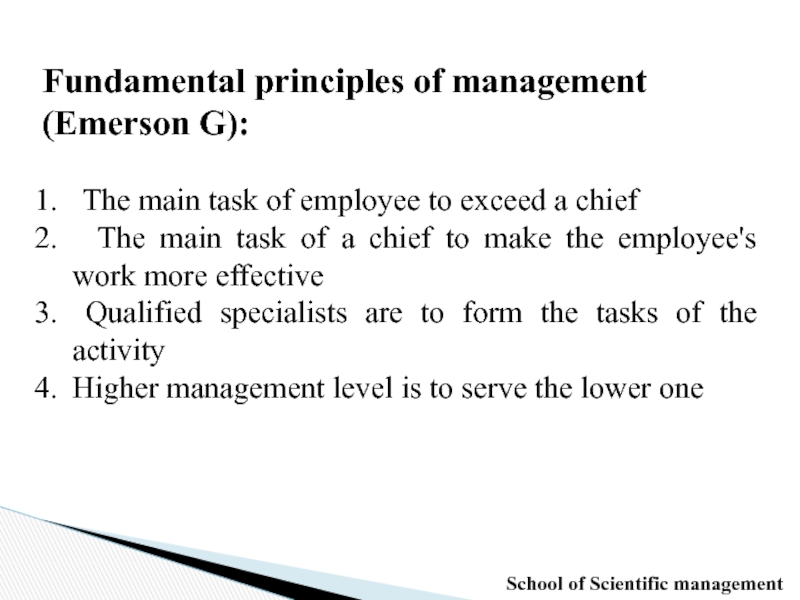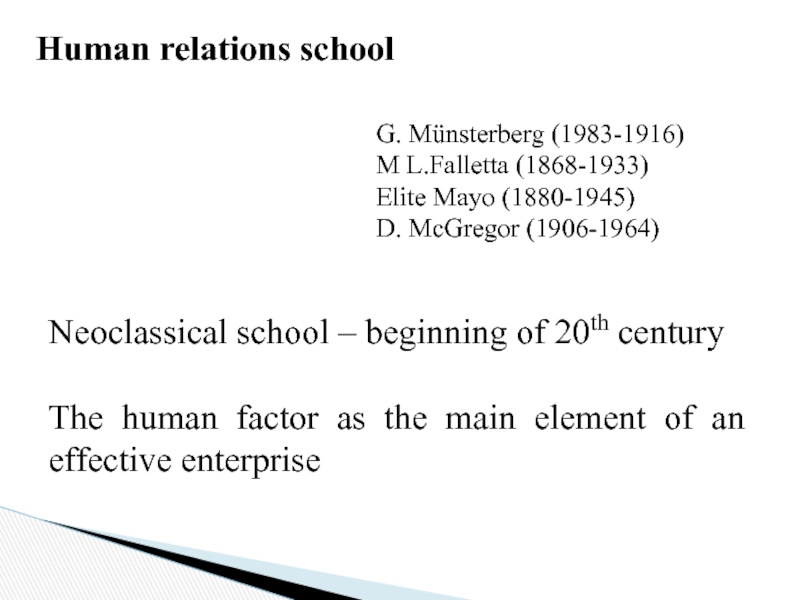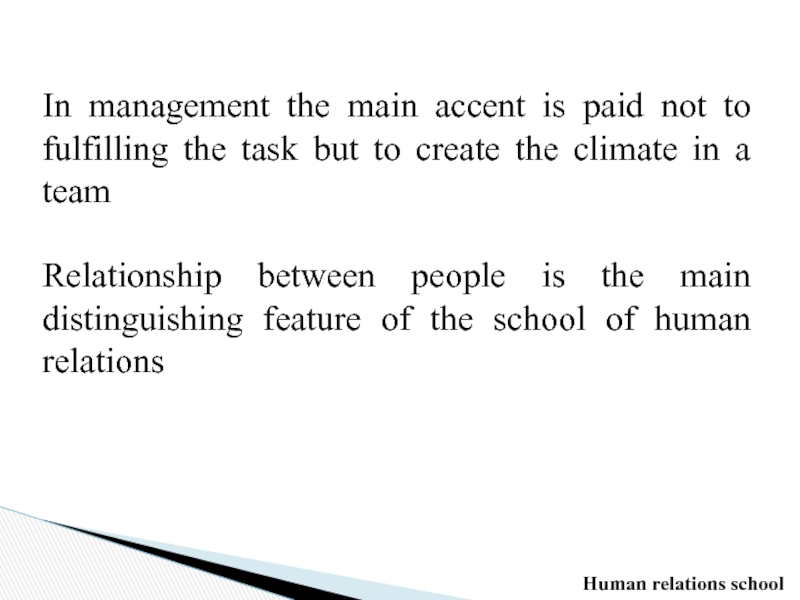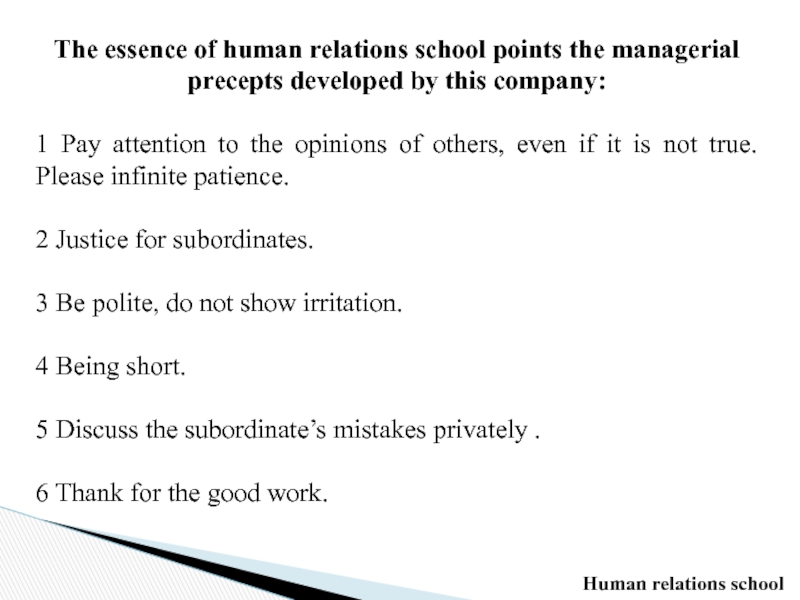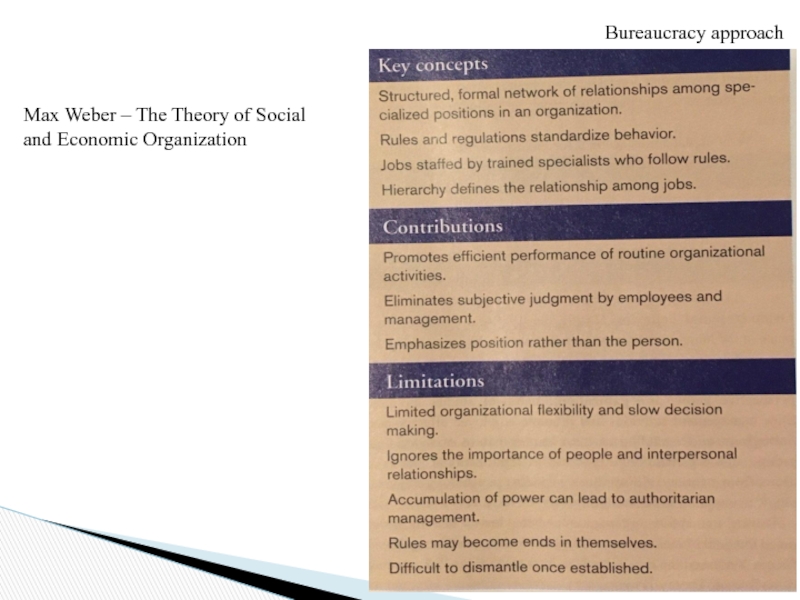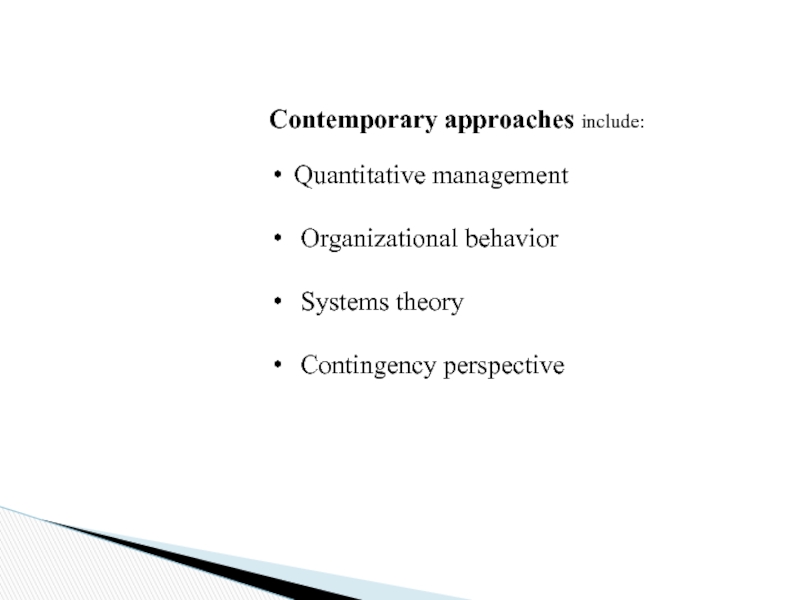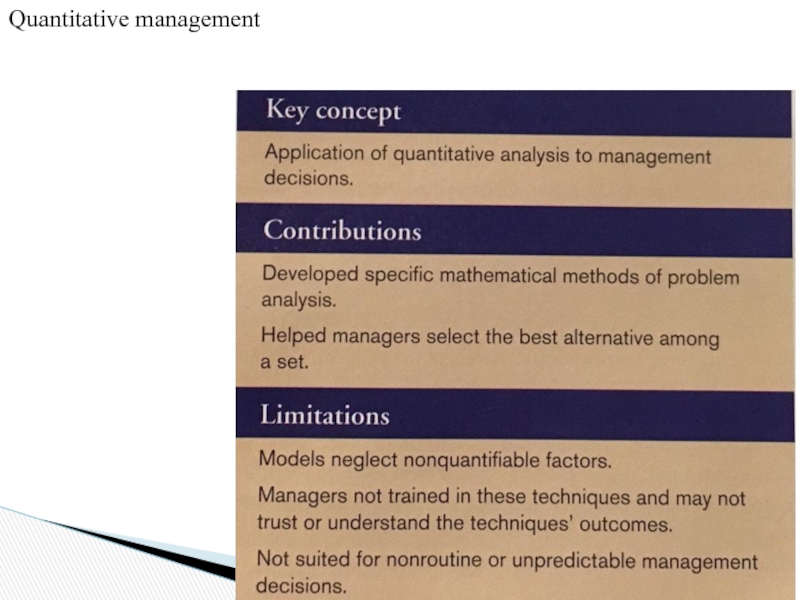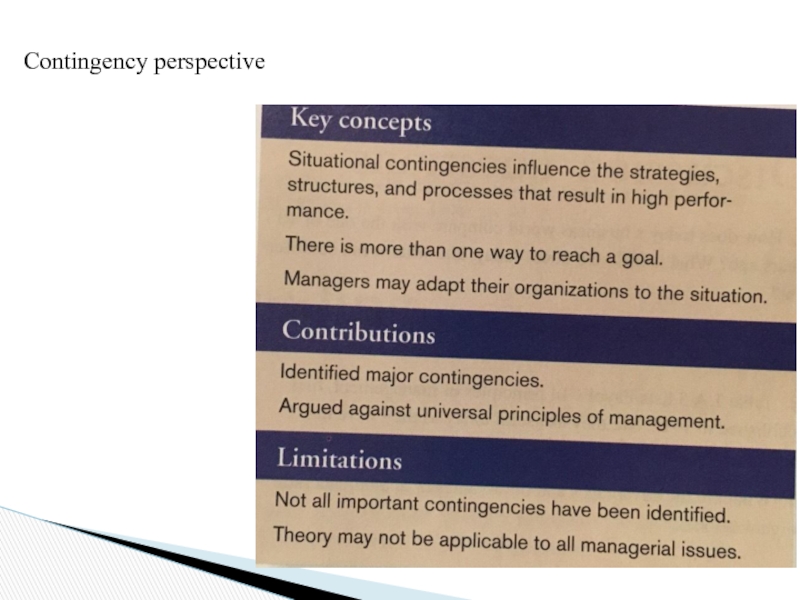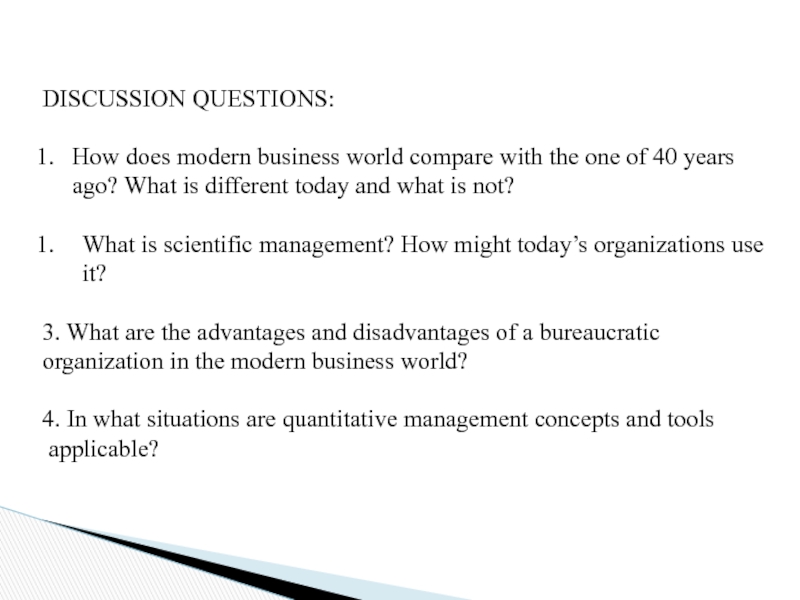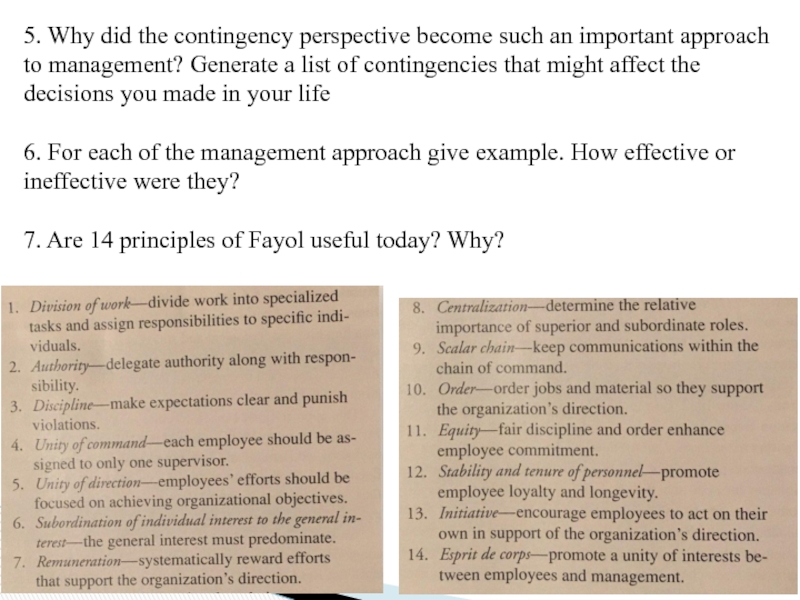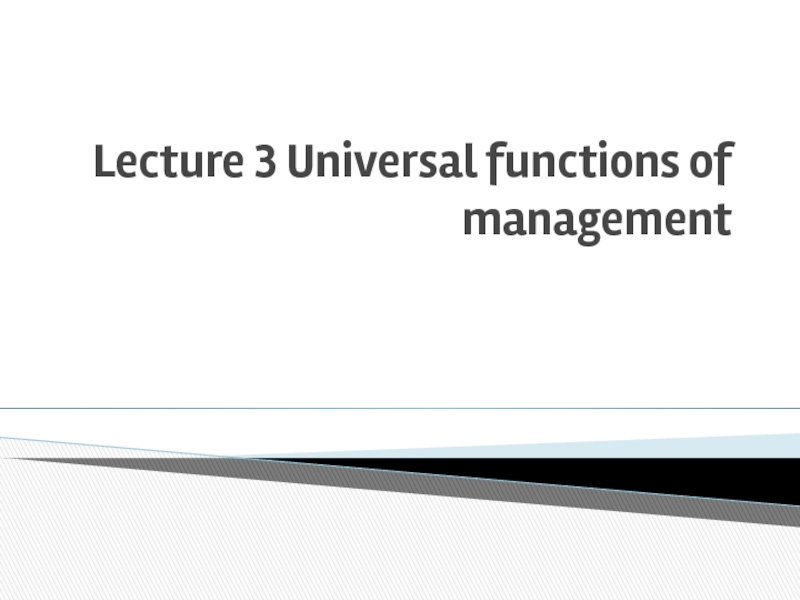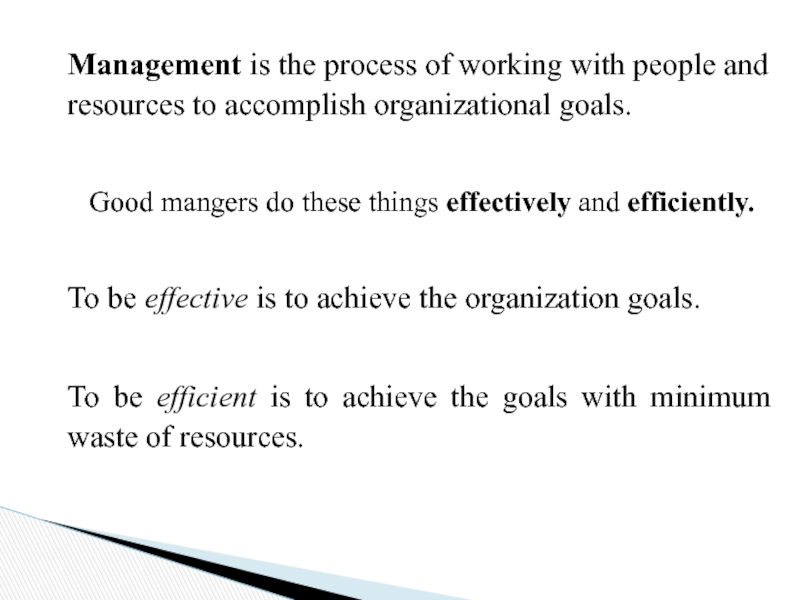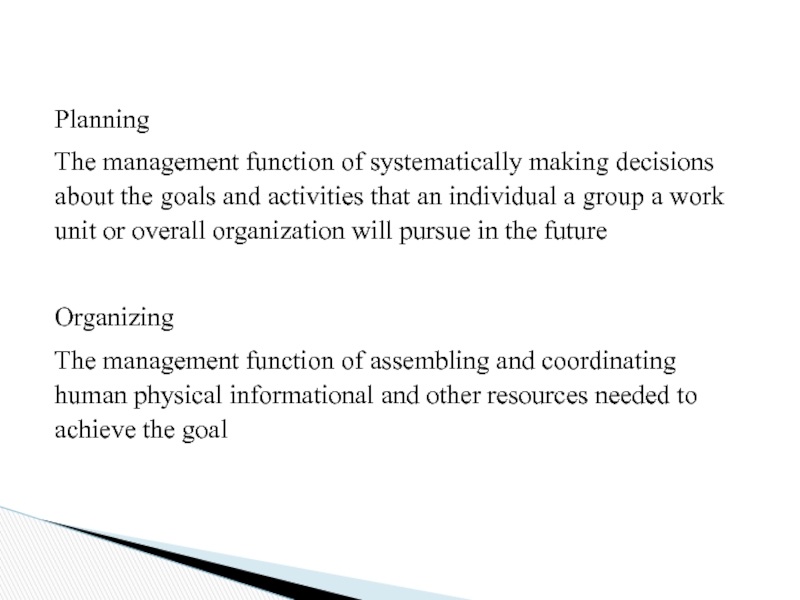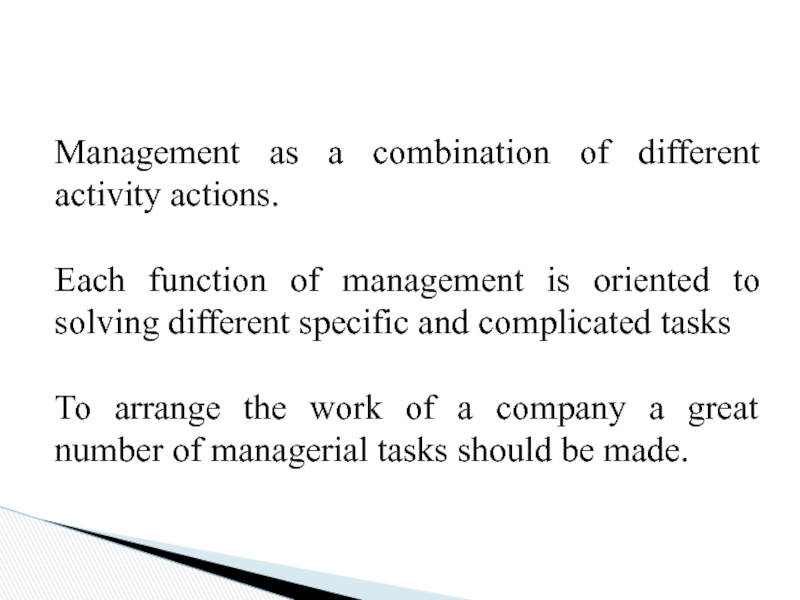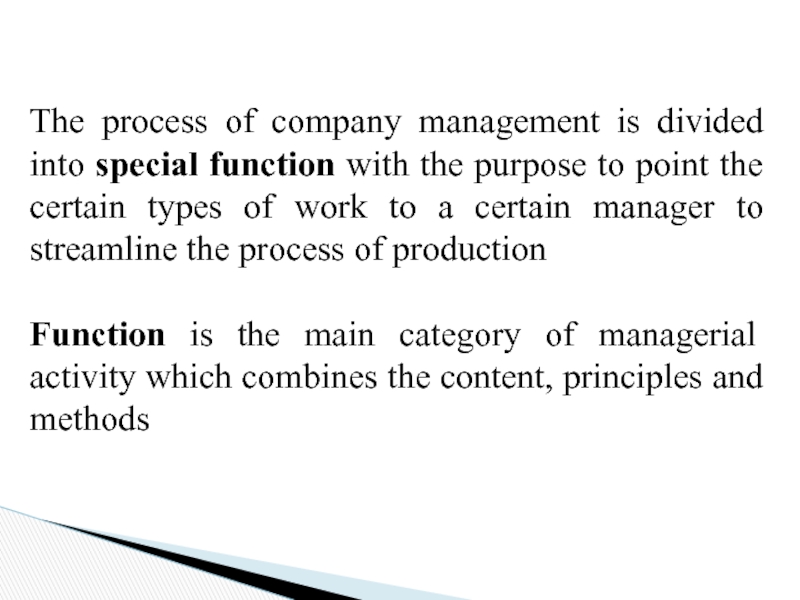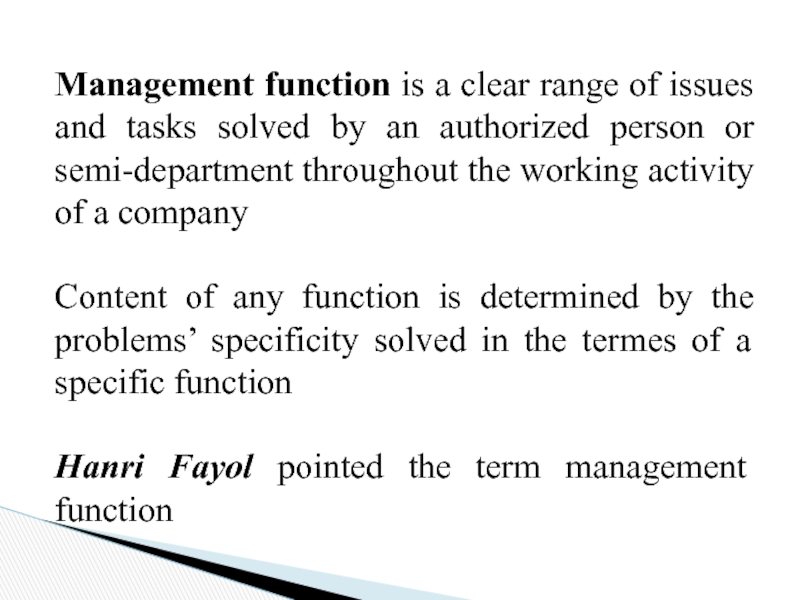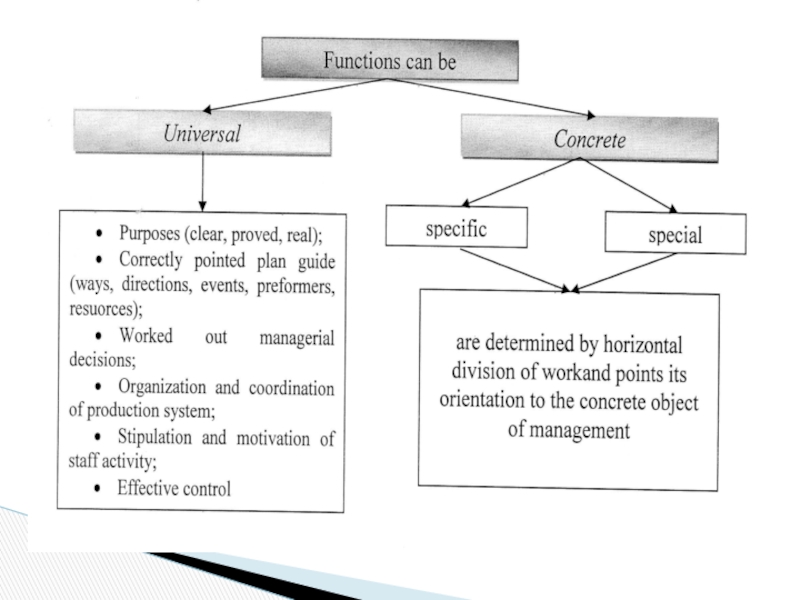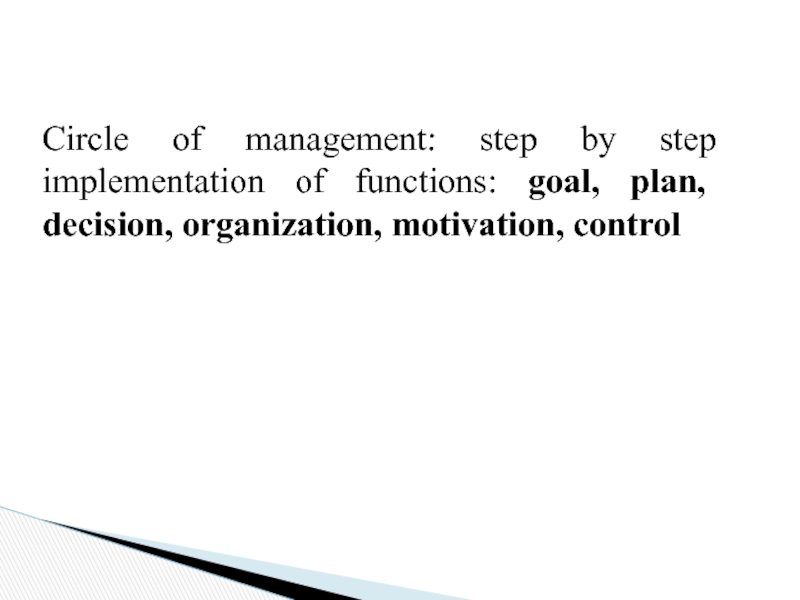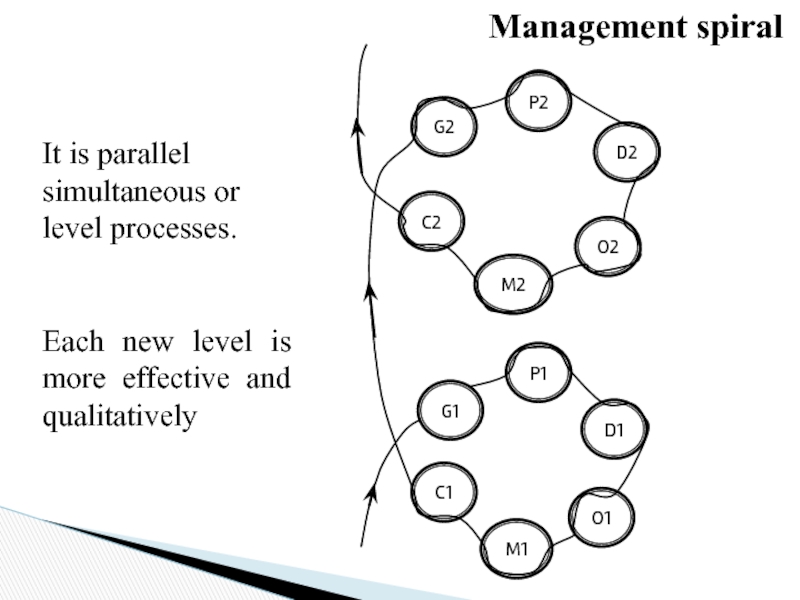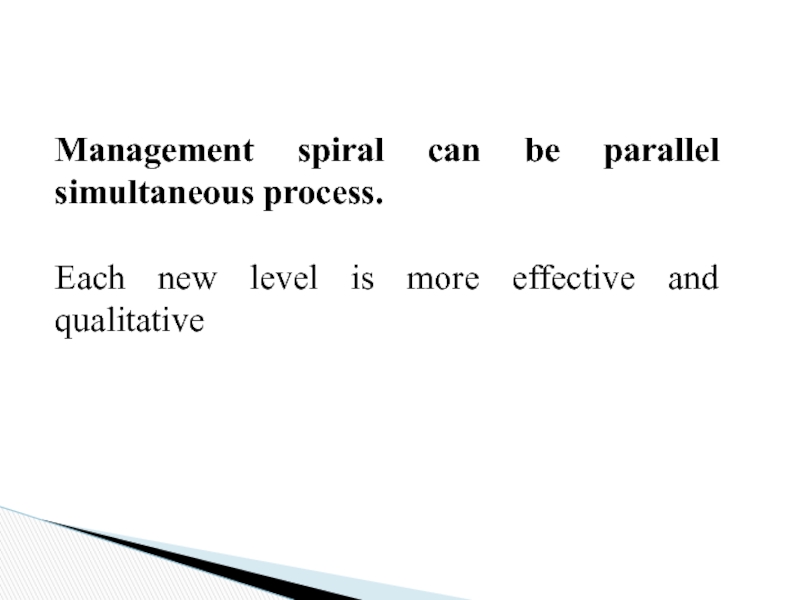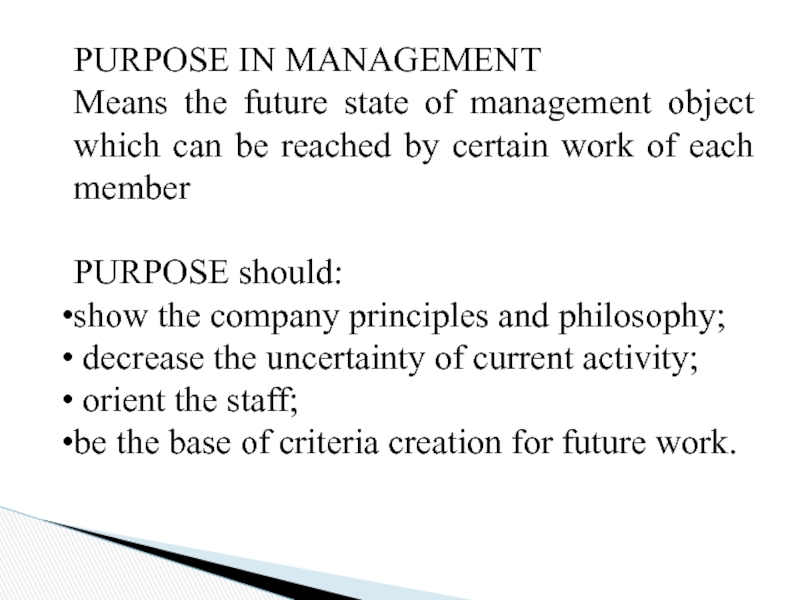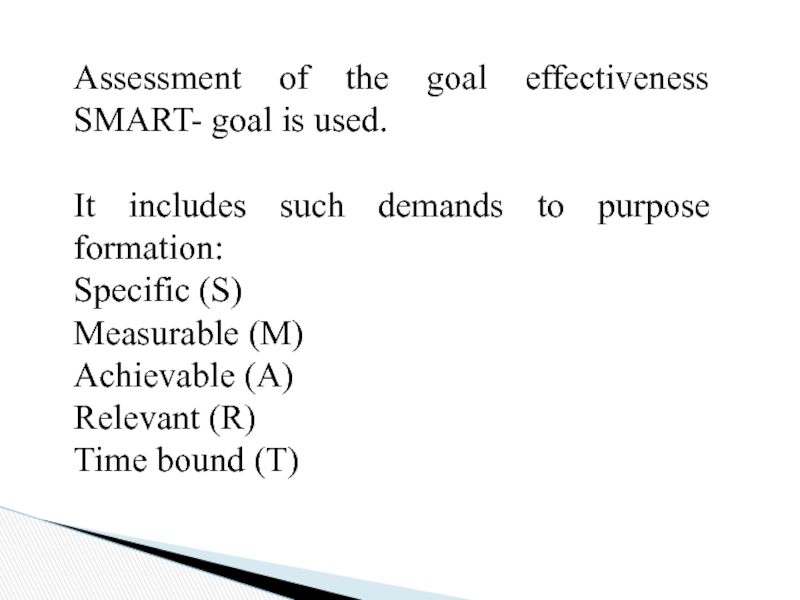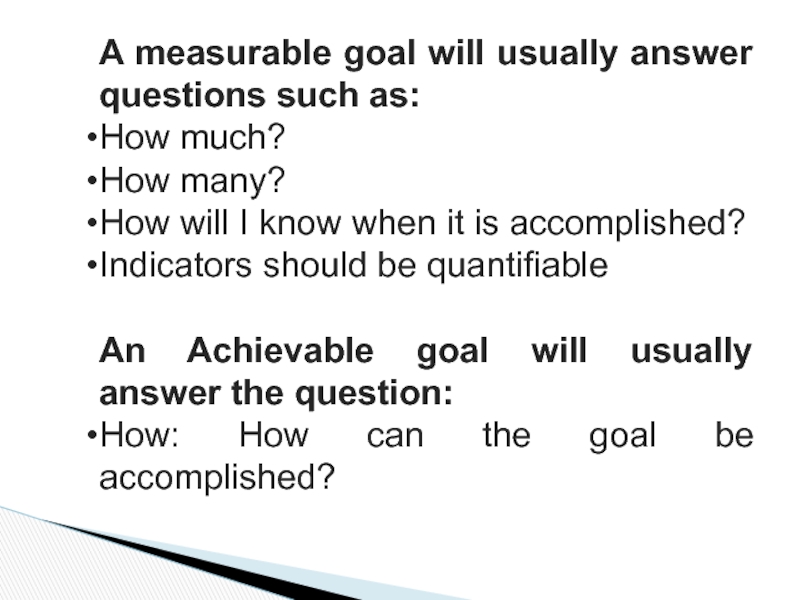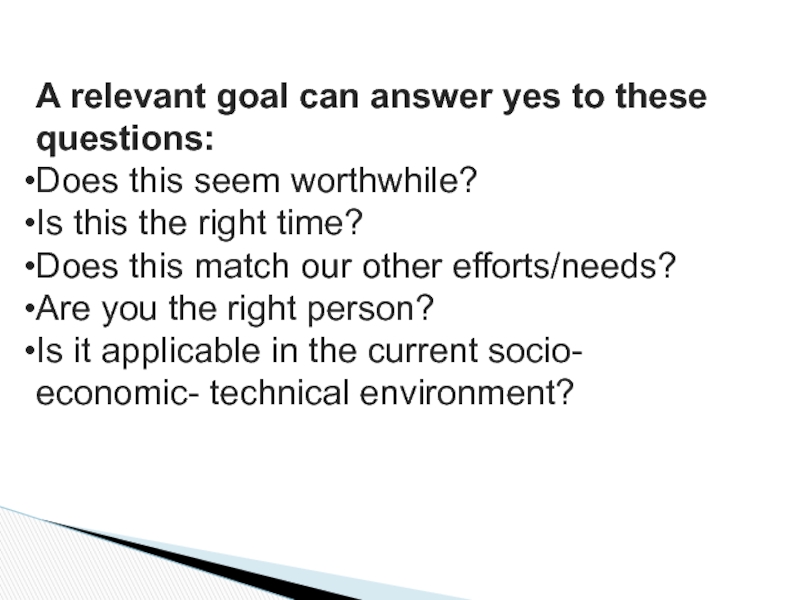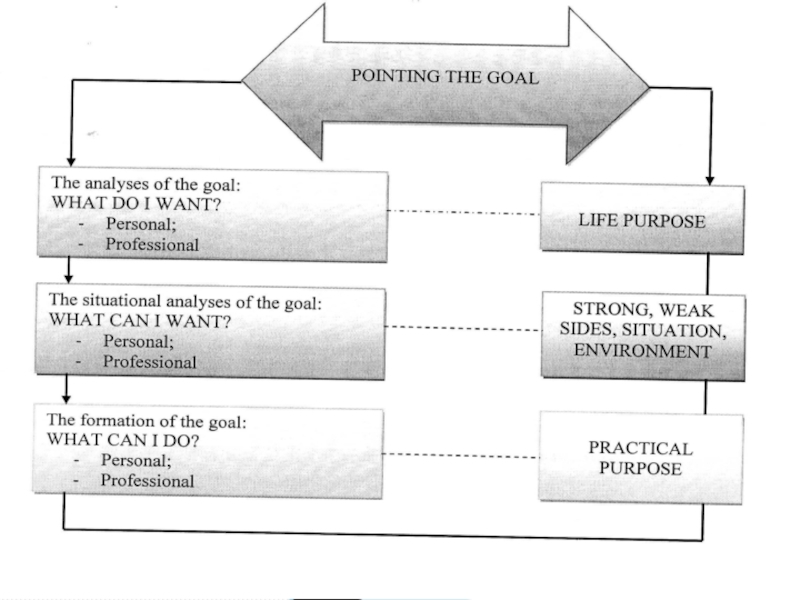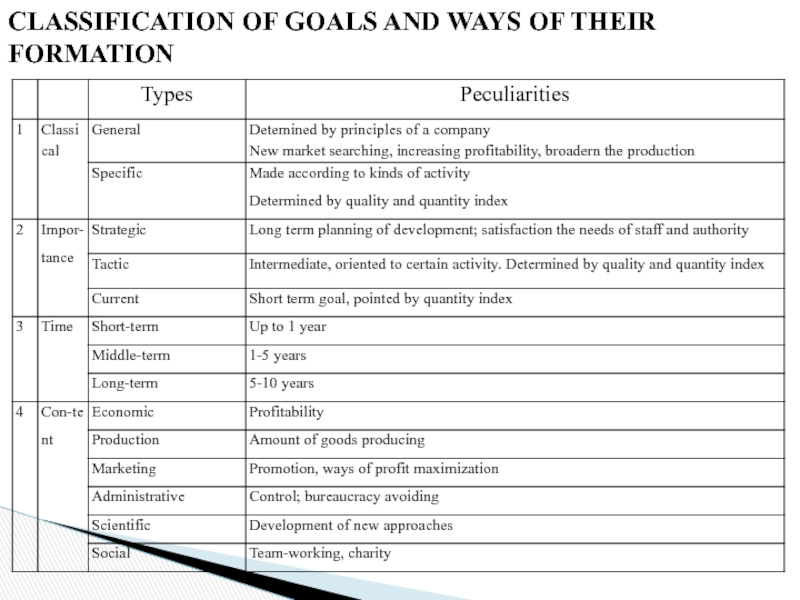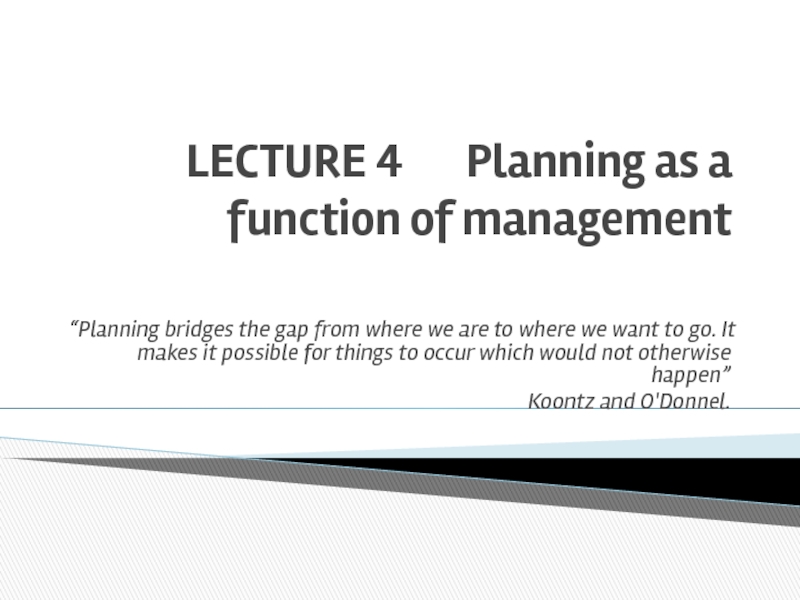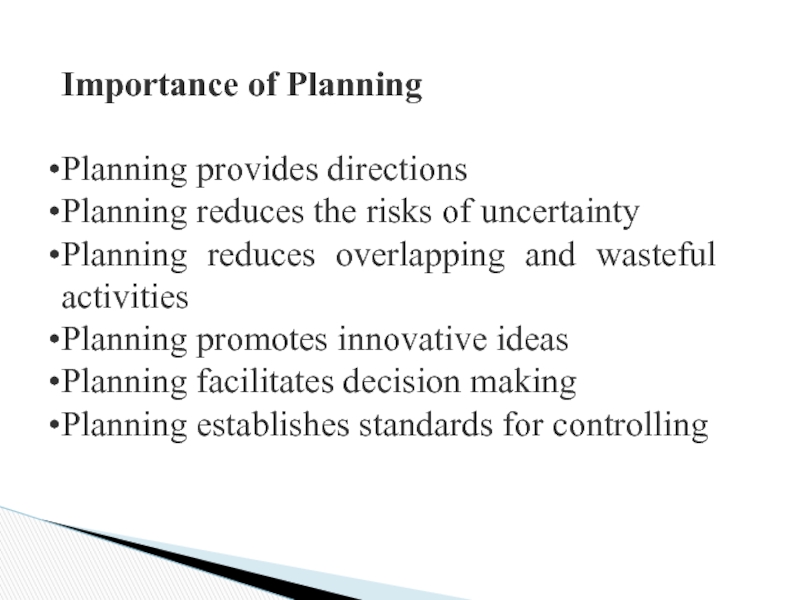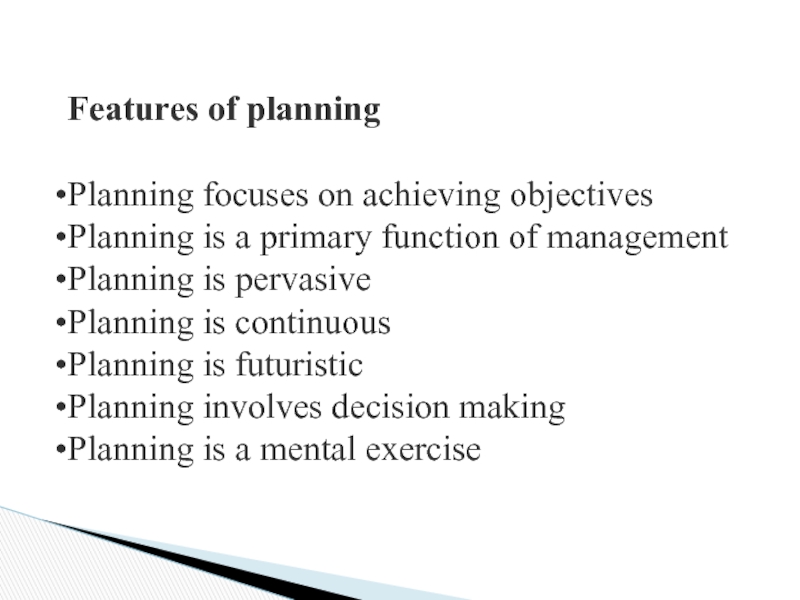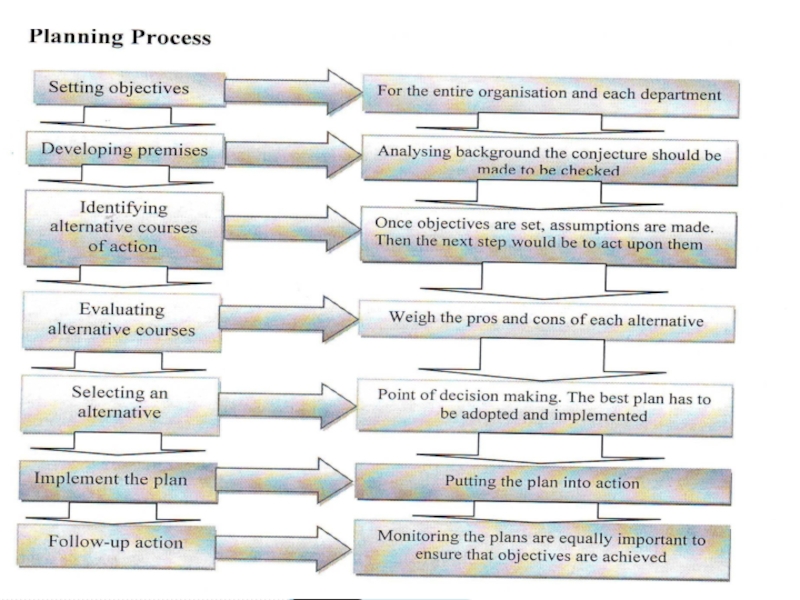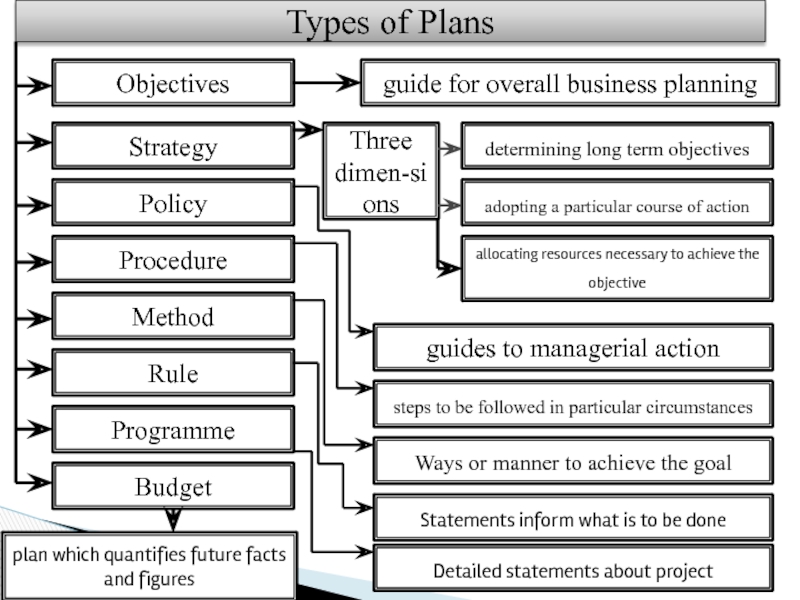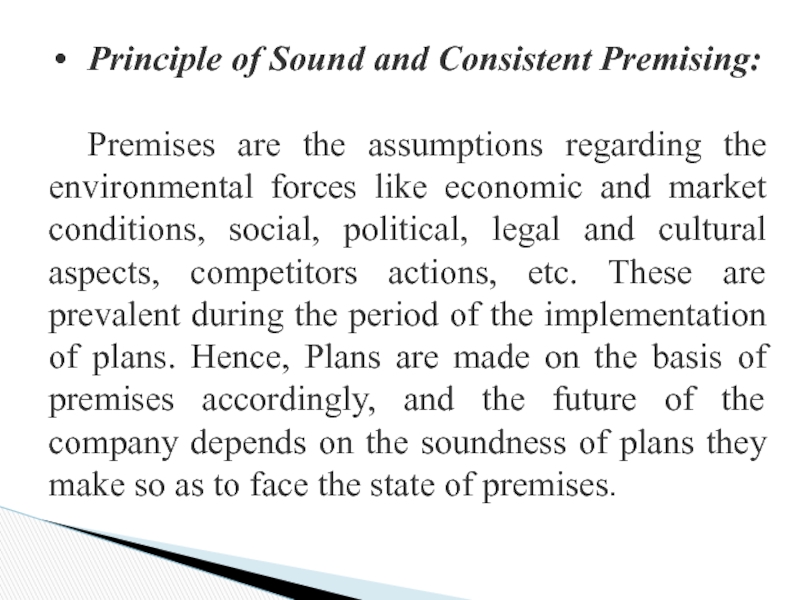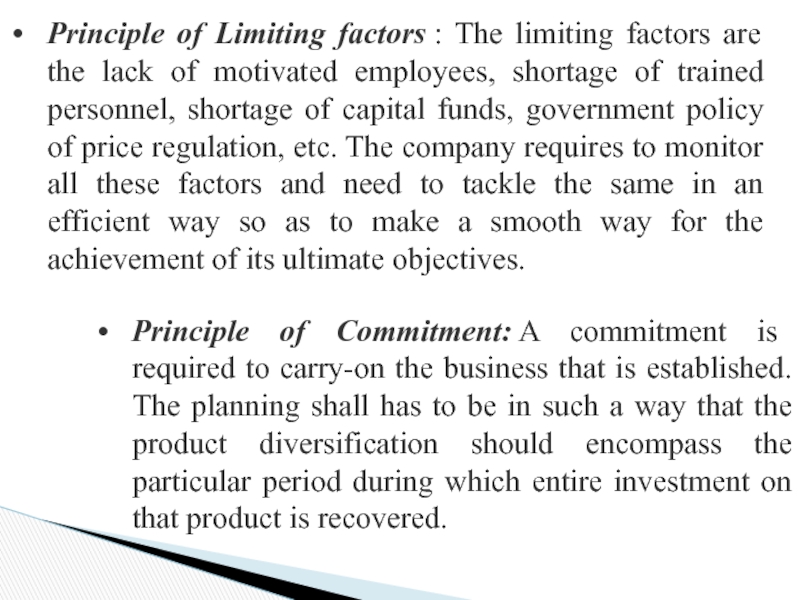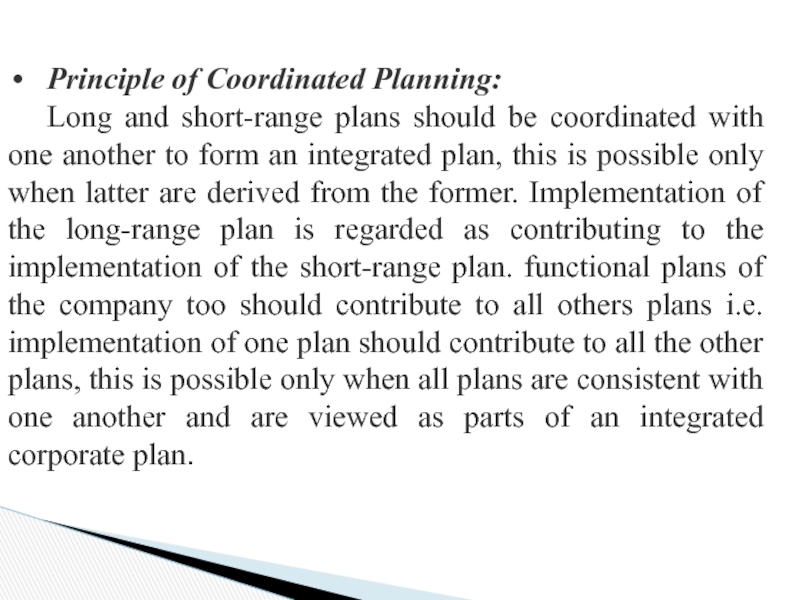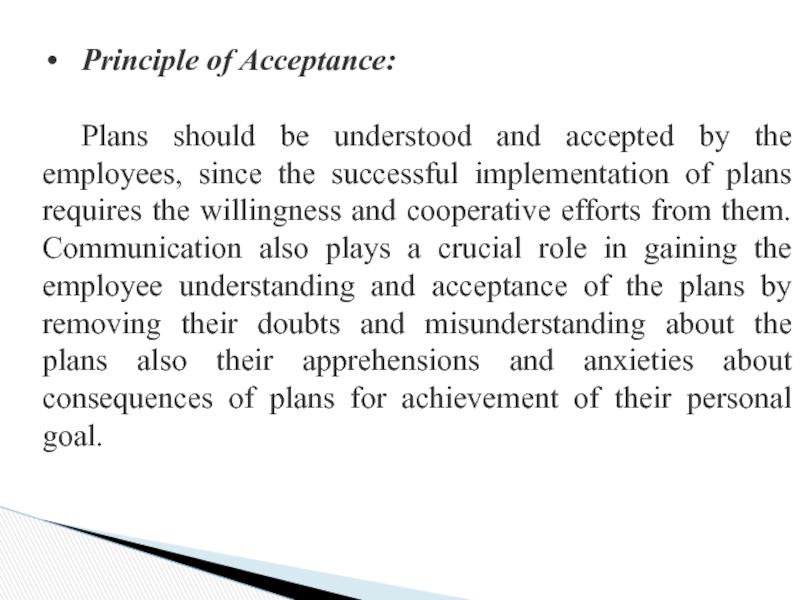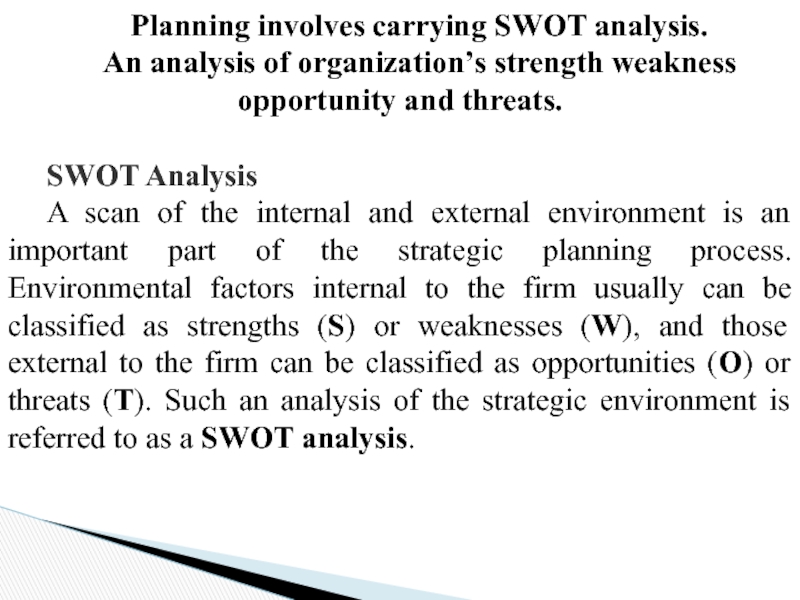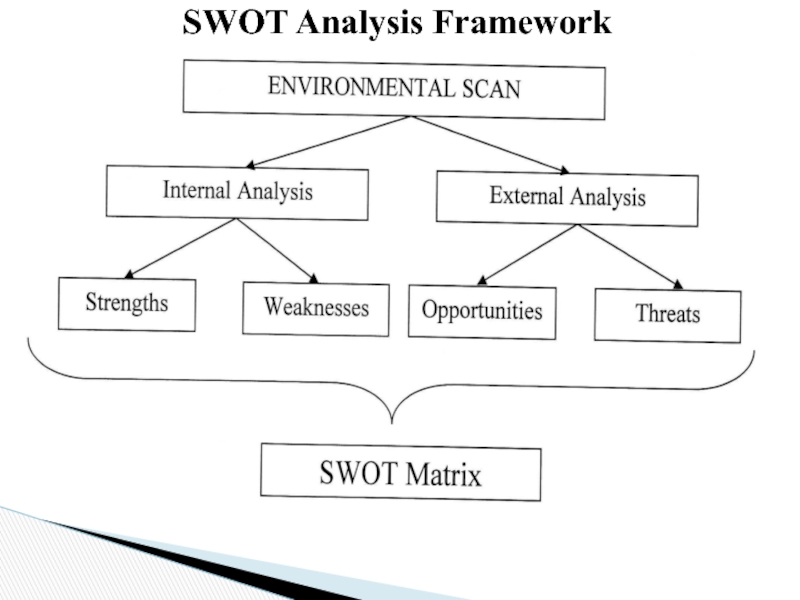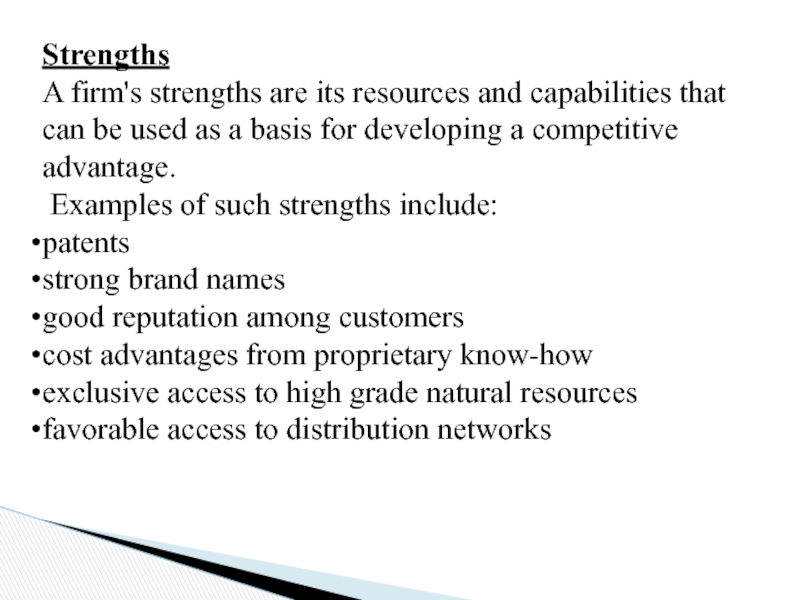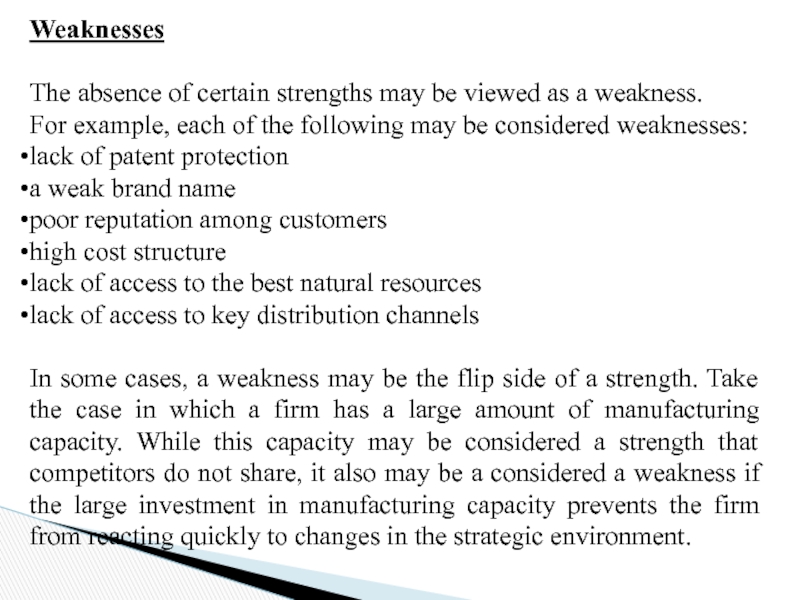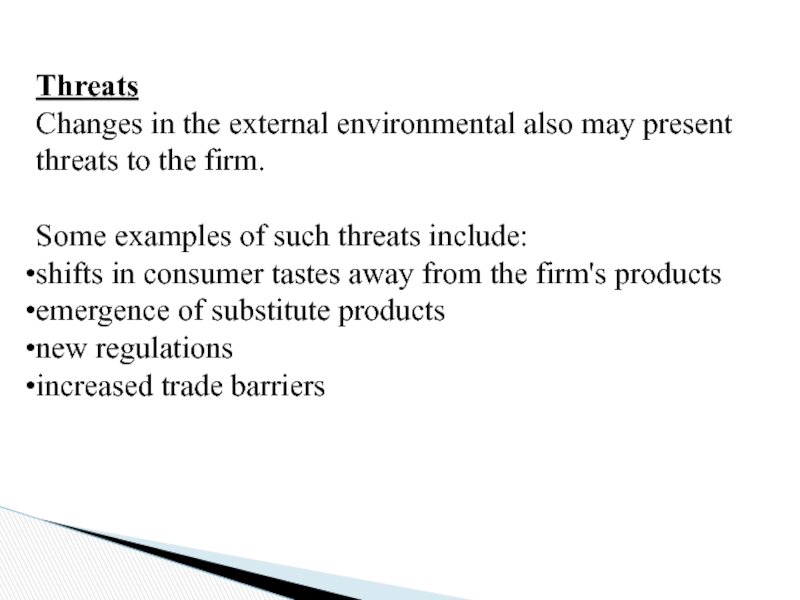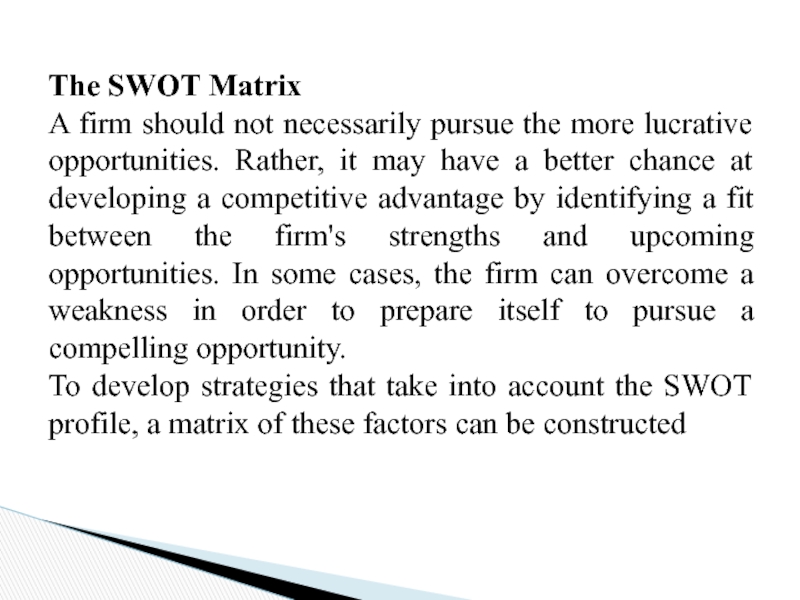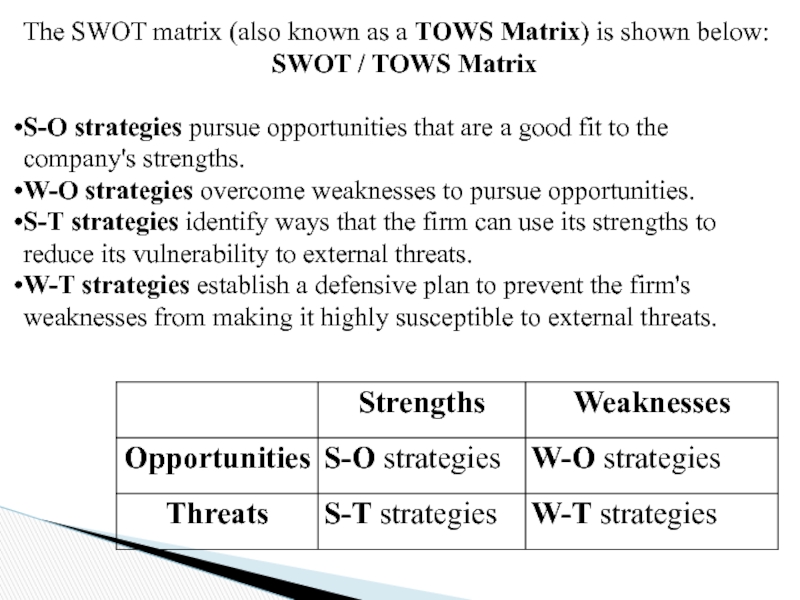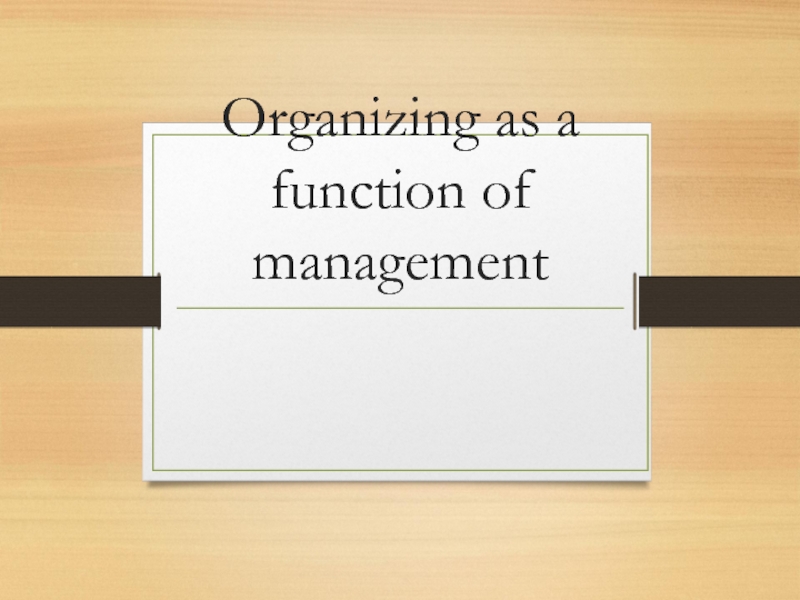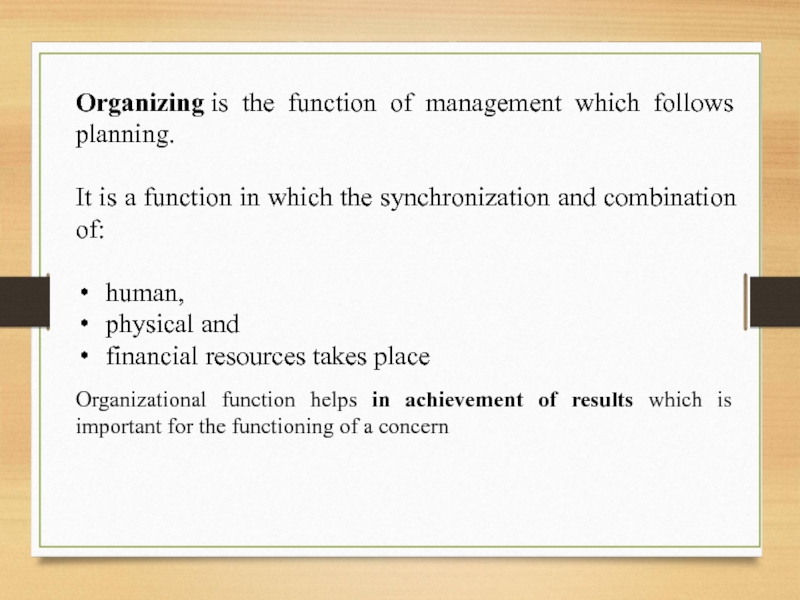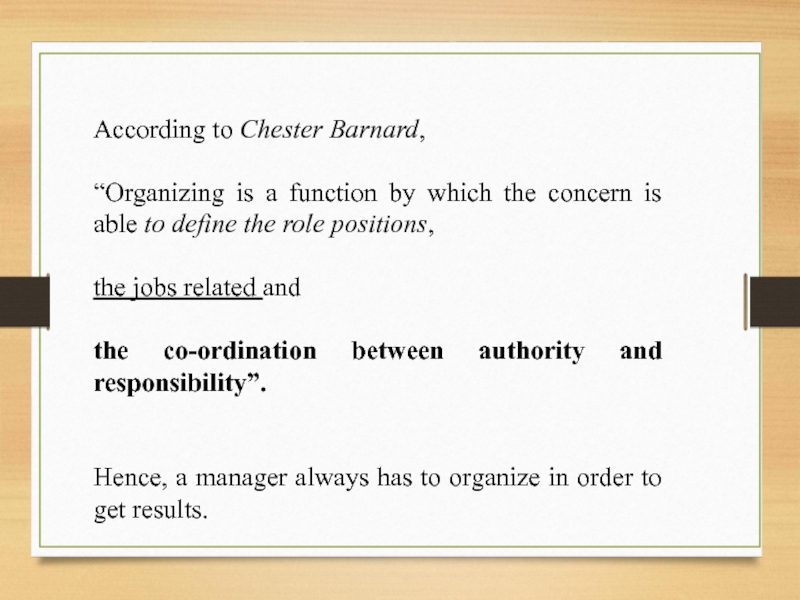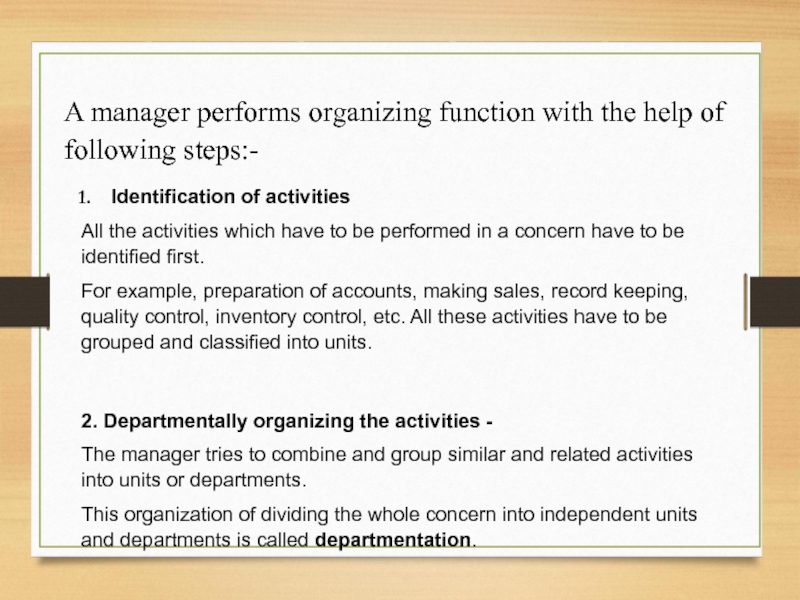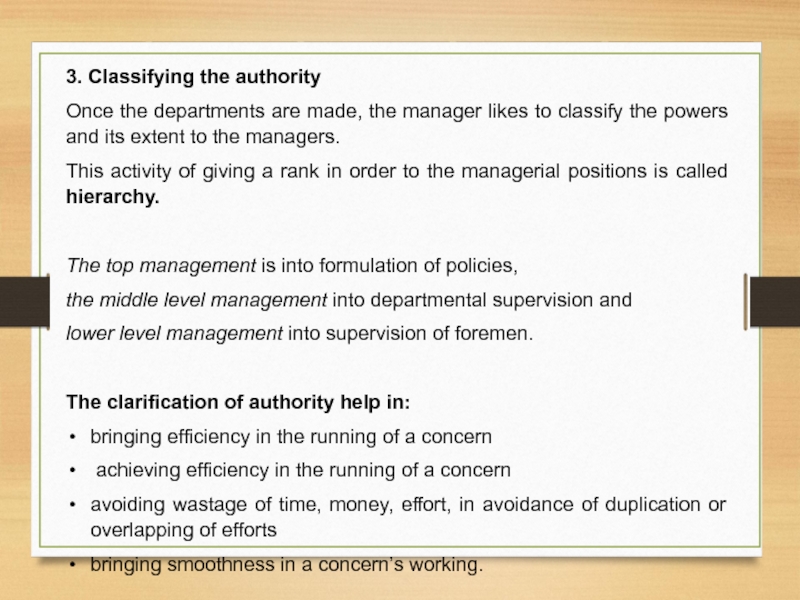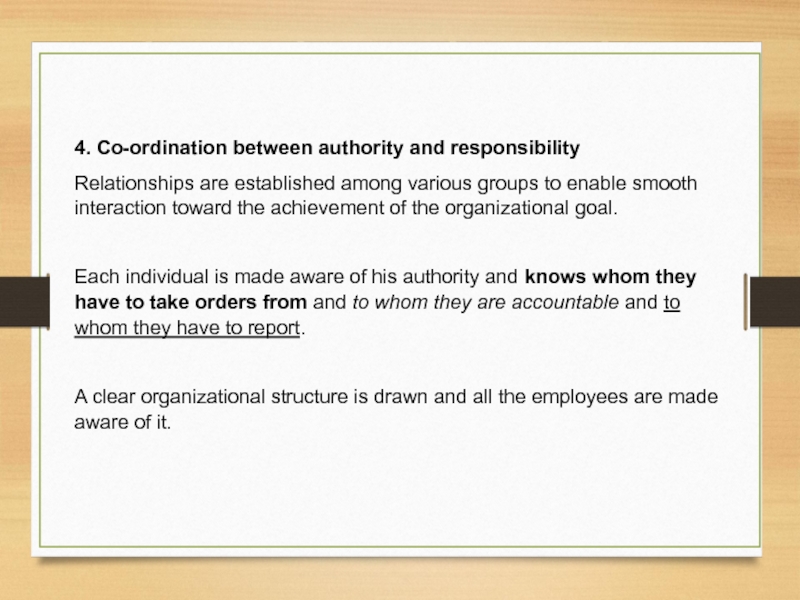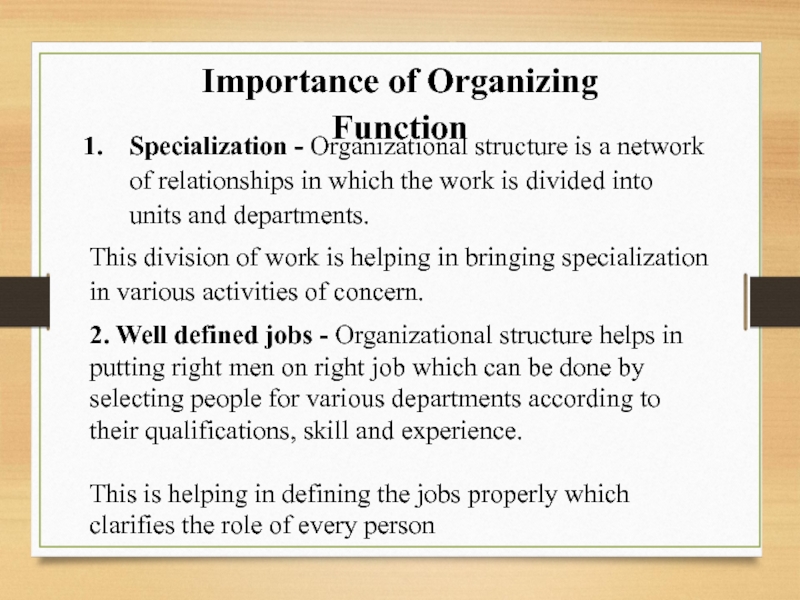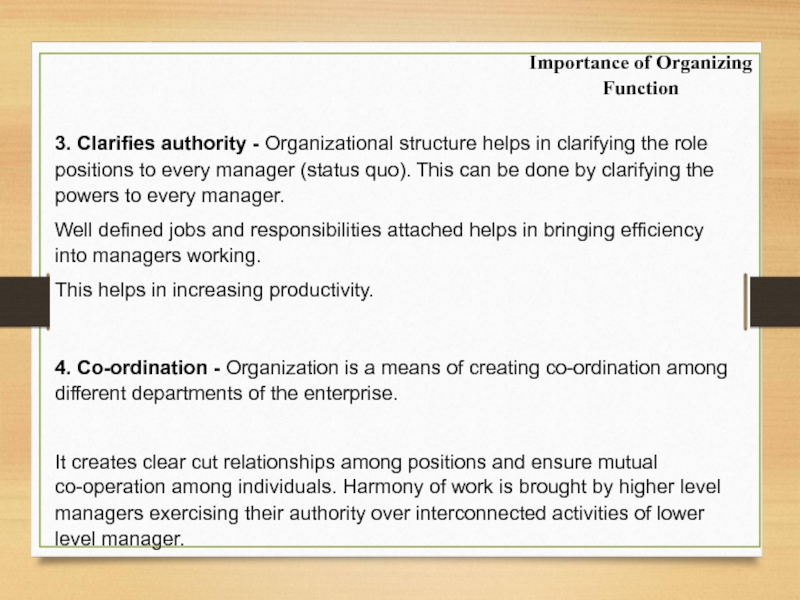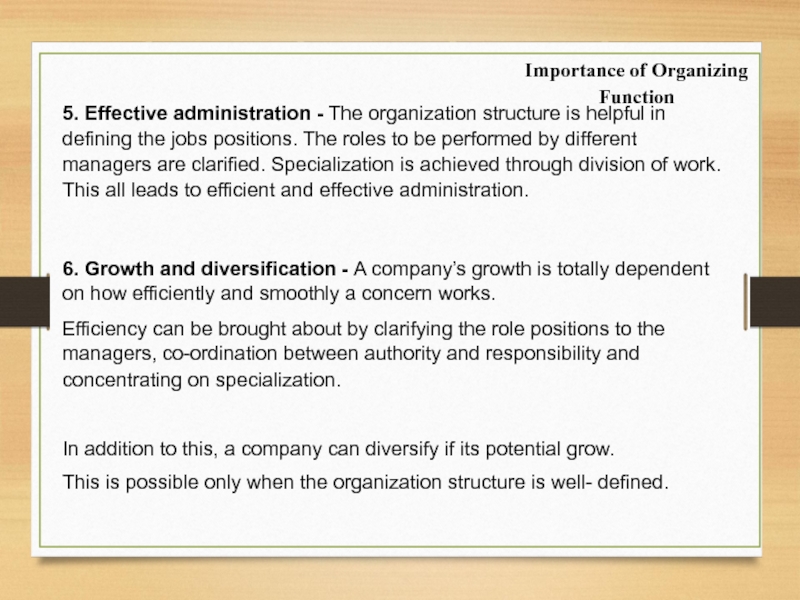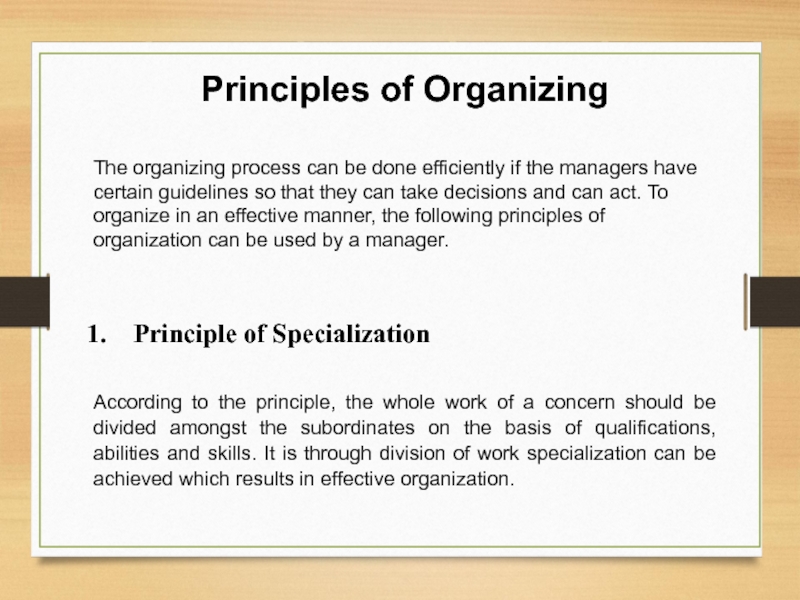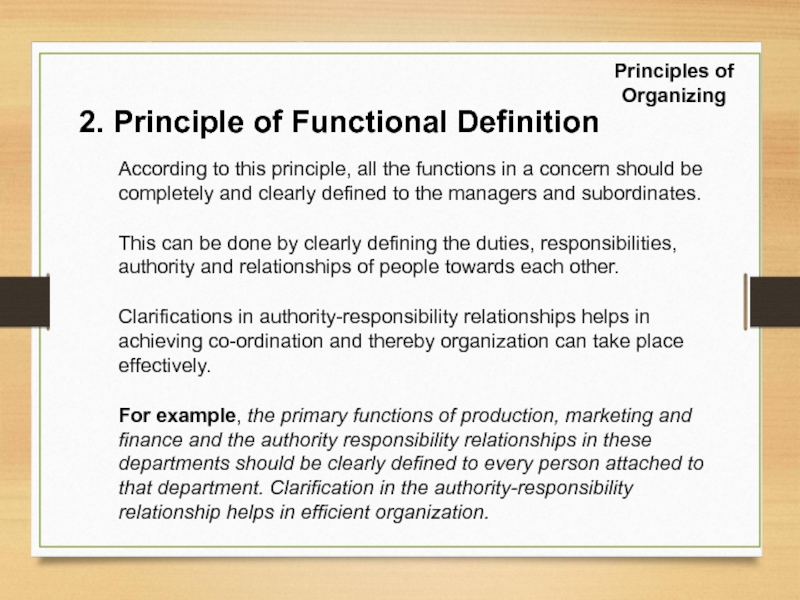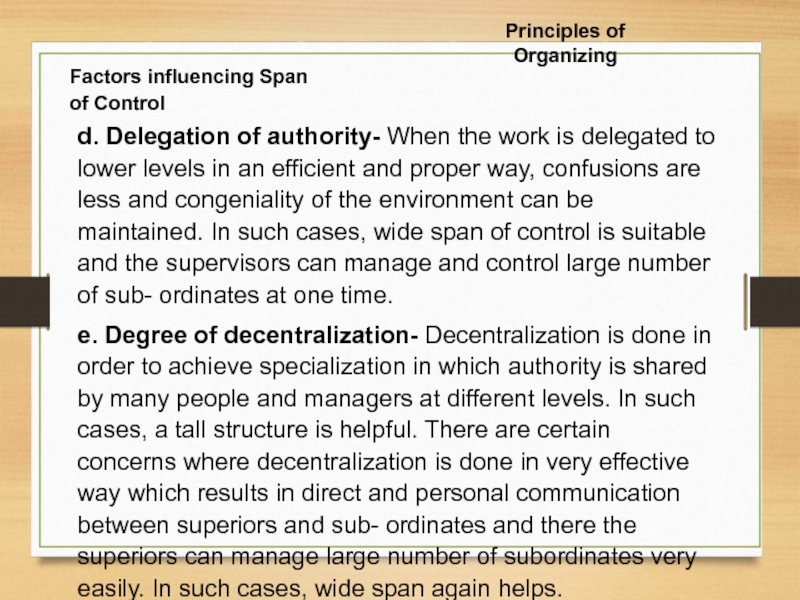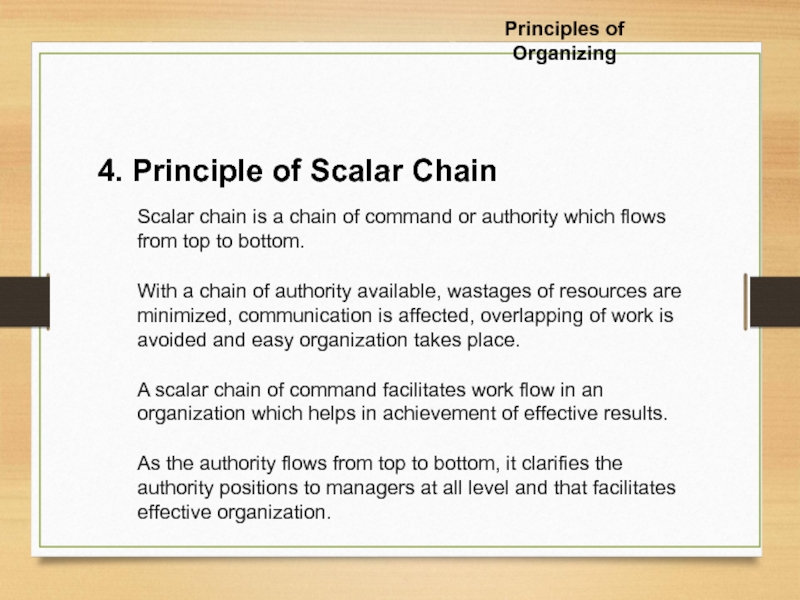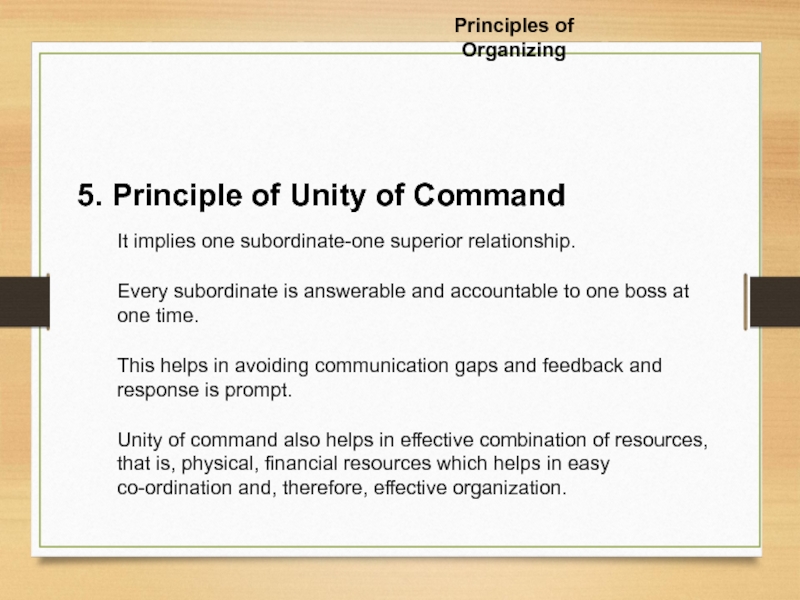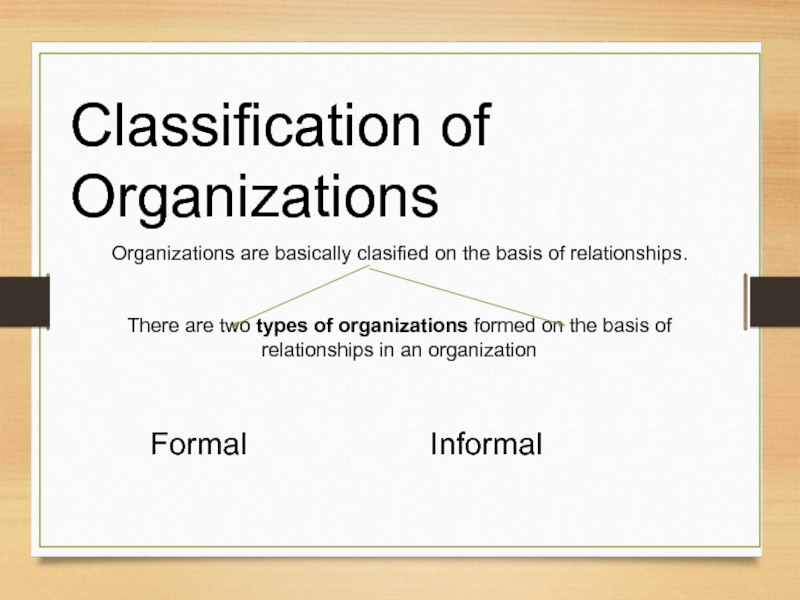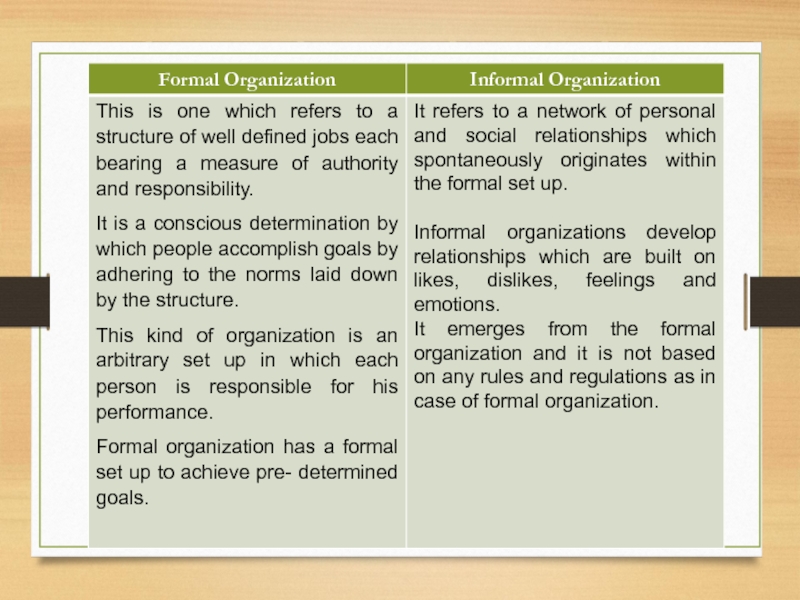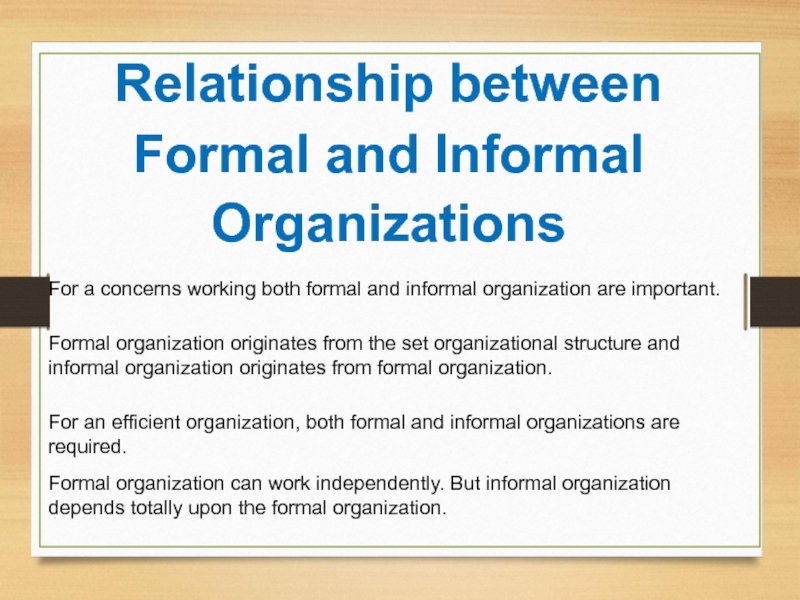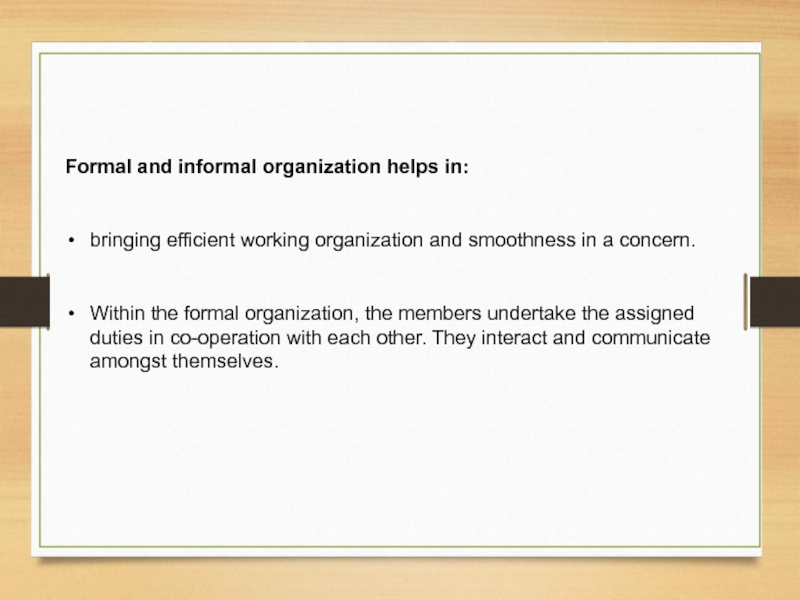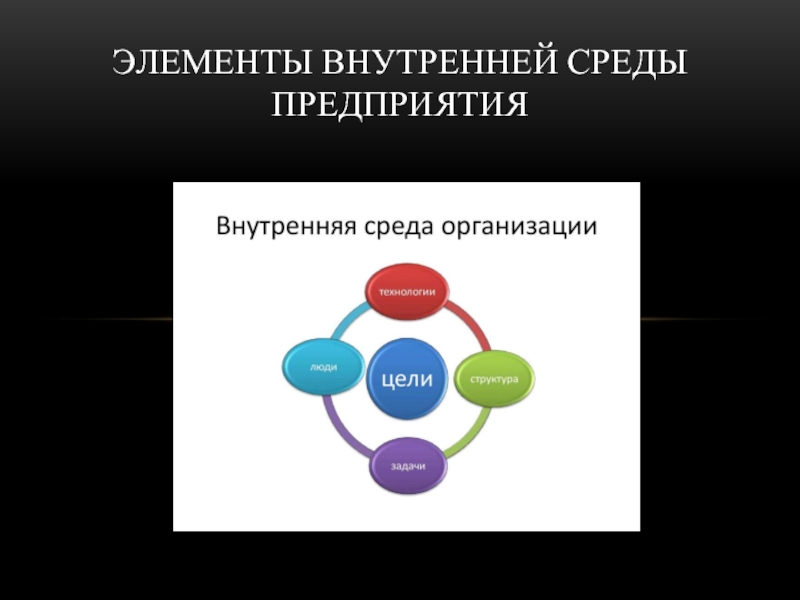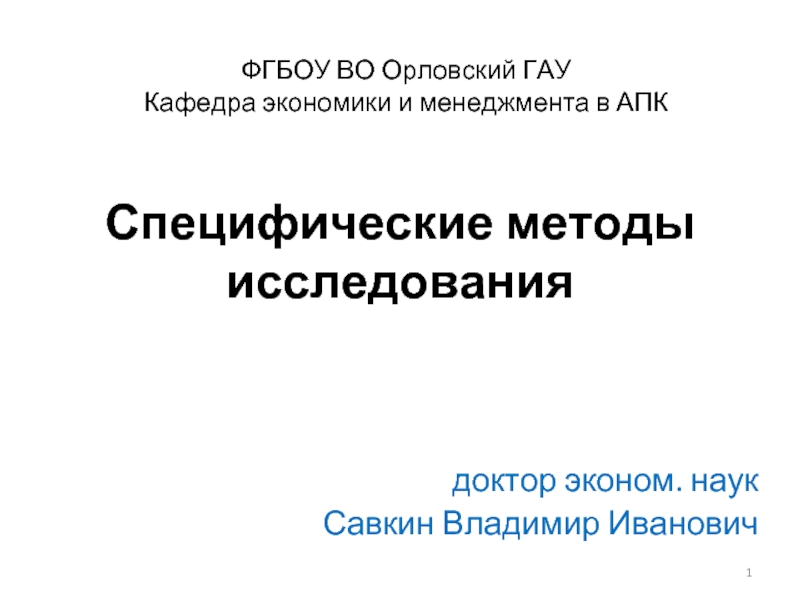- Главная
- Разное
- Дизайн
- Бизнес и предпринимательство
- Аналитика
- Образование
- Развлечения
- Красота и здоровье
- Финансы
- Государство
- Путешествия
- Спорт
- Недвижимость
- Армия
- Графика
- Культурология
- Еда и кулинария
- Лингвистика
- Английский язык
- Астрономия
- Алгебра
- Биология
- География
- Детские презентации
- Информатика
- История
- Литература
- Маркетинг
- Математика
- Медицина
- Менеджмент
- Музыка
- МХК
- Немецкий язык
- ОБЖ
- Обществознание
- Окружающий мир
- Педагогика
- Русский язык
- Технология
- Физика
- Философия
- Химия
- Шаблоны, картинки для презентаций
- Экология
- Экономика
- Юриспруденция
Priciples of management презентация
Содержание
- 1. Priciples of management
- 2. Management Economics the area of
- 3. Manager is a specialist who is hired
- 4. Management is to be oriented to
- 5. Subject - one who manages
- 6. The aim of management - is a
- 7. The object of professional activity is financial
- 8. System of management Mechanism Organizational
- 9. Mechanism consists of purpose, mission, functions, principles,
- 10. Functions of management Organization Planning
- 11. Principles of management Management principle
- 12. Management Methods: Management methods mean
- 13. THANK YOU FOR YOUR ATTENTION
- 14. Lecture 2 Historical development of management
- 15. Management as practice appeared because of the
- 16. Adam Smith pointed that the natural desire
- 17. The formation of management as a science
- 18. The evaluation of management thought
- 19. Scientists (founders of management): Frederick Taylor
- 20. Classical approaches: Systematic Scientific
- 21. Systematic approach Systematic approach tried to
- 22. Systematic approach
- 23. Administrative -classical school of managers
- 24. Administrative -classical school of managers The
- 25. 14 principles of administration: Administrative -classical school of managers
- 26. 1 Division of work 2 Power
- 27. Henri Fayol points the operation groups in management:
- 28. The contribution of this school is that
- 29. School of Scientific management F.Taylor is
- 30. Taylor's basic views presented in the books
- 31. The merit of Taylor’s works: 1
- 32. The merit of Taylor’s works for
- 33. The main idea is that based on
- 34. Fundamental principles of management (Emerson G):
- 35. Human relations school G. Münsterberg (1983-1916)
- 36. In management the main accent is paid
- 37. The essence of human relations school points
- 38. Bureaucracy approach Max Weber – The Theory of Social and Economic Organization
- 39. Contemporary approaches include: Quantitative management
- 40. Quantitative management
- 41. Organizational behavior
- 42. Contingency perspective
- 43. DISCUSSION QUESTIONS: How does modern business
- 44. 5. Why did the contingency perspective become
- 45. THANK YOU FOR YOUR ATTENTION
- 46. Lecture 3 Universal functions of management
- 47. Management is the process of working with
- 48. Planning The management function of systematically
- 49. Leading The management function that involves the
- 50. Management as a combination of different activity
- 51. Two main questions should be answered:
- 52. The process of company management is divided
- 53. Management function is a clear range of
- 55. Circle of management: step by step implementation of functions: goal, plan, decision, organization, motivation, control
- 56. G1 M1 P1 O1 D1 C1 C2
- 57. Management spiral can be parallel simultaneous process.
- 58. PURPOSE IN MANAGEMENT Means the future state
- 59. Assessment of the goal effectiveness SMART- goal
- 60. A specific goal will usually answer the
- 61. A measurable goal will usually answer questions
- 62. A relevant goal can answer yes to
- 63. A time-bound goal will usually answer the
- 65. GOAL should be clear. Examples:
- 66. CLASSIFICATION OF GOALS AND WAYS OF THEIR FORMATION
- 67. Quantity index segments
- 68. EXAMPLE OF SMART Goal Broad Goal: I
- 69. Attainable: I will get set up
- 70. Relevant: Selling handmade cards will allow me
- 71. LECTURE 4 Planning as a function of
- 72. Planning is bridging the gap between present
- 73. Importance of Planning Planning provides directions
- 74. Features of planning Planning focuses on
- 76. Types of Plans Objectives Rule
- 77. Management Planning Principles Planing is a
- 78. Principle of Contribution: The purpose
- 79. Principle of Sound and Consistent Premising:
- 80. Principle of Limiting factors : The limiting factors
- 81. Principle of Coordinated Planning: Long and short-range
- 82. Principle of Timing: Number of major and
- 83. Principle of Flexibility: Plans are supposed to
- 84. Principle of Acceptance: Plans should
- 85. Planning involves carrying SWOT analysis. An
- 86. SWOT Analysis Framework
- 87. Strengths A firm's strengths are its resources
- 88. Weaknesses The absence of certain strengths
- 89. Opportunities The external environmental analysis may
- 90. Threats Changes in the external environmental also
- 91. The SWOT Matrix A firm should not
- 92. The SWOT matrix (also known as a TOWS
- 93. Organizing as a function of management
- 94. Organizing is the function of management which follows
- 95. According to Chester Barnard, “Organizing is
- 96. A manager performs organizing function with the
- 97. 3. Classifying the authority Once the
- 98. 4. Co-ordination between authority and responsibility
- 99. Importance of Organizing Function Specialization - Organizational structure
- 100. 3. Clarifies authority - Organizational structure helps in
- 101. 5. Effective administration - The organization structure is
- 102. 7. Sense of security - Organizational structure clarifies
- 103. Principles of Organizing The organizing process
- 104. 2. Principle of Functional Definition According to
- 105. 3. Principles of Span of Control/Supervision According
- 106. Wide span of control- It is one in
- 107. b. Narrow span of control- According to this
- 108. Factors influencing Span of Control Managerial
- 109. d. Delegation of authority- When the work is
- 110. 4. Principle of Scalar Chain Scalar chain
- 111. 5. Principle of Unity of Command It
- 112. Classification of Organizations Organizations are basically clasified
- 114. Relationship between Formal and Informal Organizations
- 115. Formal and informal organization helps in:
- 116. THANK YOU FOR YOUR ATTENTION
Слайд 2Management
Economics
the area of managerial and economic activity which provides
Psychology
the ability, the manner of dealing with people, power and the art of management, a special kind of skills and administrative skills, organization of management, administrative unit
Sociology
the process of optimizing the human being and his material and financial resources; also it is th art as it demands constant creativity
Слайд 3Manager is a specialist who is hired to organize and manage
Management is the process of organization planning, motivation and control important for formation a goal and its reaching .
Management is a conscious human activity with the help of which he regulates and subordinates the external elements to his interests.
Слайд 5Subject - one who manages
Object - the one who is
So the main task of management is to organize the work of other people (cooperation)
Слайд 6The aim of management - is a desired, posible and necessary
The subject of management is people (subordinate, co-workers)
Product of management is a labor management solution.
Price of solution is determined by cost and profit.
Byproduct in management is: a control system, the psychological climate.
Слайд 7The object of professional activity is financial and economic activity of
Business management - is the management of commercial, economic organizations.
Слайд 8System of management
Mechanism
Organizational structures of management
Management process
Technical support
Слайд 9Mechanism consists of purpose, mission, functions, principles, methods of management.
Organizational
Management process means the technology of managerial decision-making and the organization of their implementations.
Слайд 10Functions of management
Organization
Planning
Control
Motivation
Information, goals of the
Managerial decision
Coordination and timing
Changes making
Registration and accounting
Слайд 11Principles of management
Management principle means laws and norms to be
1. Determination of the goals and objectives of management;
2. Development the specific measures to achieve them;
3. The division of tasks for certain types of work;
4 Coordination of interactions between various departments and the organization;
5 Formation of the hierarchical structure;
6 Optimization of decision-making;
7 Motivation, stimulation effects to work.
Слайд 12Management Methods:
Management methods mean methods and forms of the head’s
Organizational-instructional
Economic
Social -physiological
Слайд 15Management as practice appeared because of the understanding that:
to achieve the
Слайд 16Adam Smith pointed that the natural desire to increase wealth is
Слайд 17The formation of management as a science
is determined by
needs and demands
the scientific working outs of the most effective methods to fulfill the work
Слайд 19Scientists (founders of management):
Frederick Taylor (1856-1915);
Harrington Emerson (1853-1931);
Henri Fayol (1841-1925)
Слайд 21Systematic approach
Systematic approach tried to build specific procedures and process
It emphasized economical operations, adequate staffing, maintenance of inventories to meet consumer demand, and organizational control
It was done through:
Careful definition of duties and responsibilities
Standardized techniques for performing the duties
Specific means of gathering, handling, transmitting and analyzing information
Слайд 23Administrative -classical school of managers
Henri Fayol (1841 - 1825) created a
Followers:
H.Emerson, L.Guleek, A.Railly, Ch.Bernard worked on the creation of general (universal) principles of management
Слайд 24Administrative -classical school of managers
The working out the rational structure
Human management
Division of the company to departments and semi-departments
Bureaucratic system of management based on clearly defined rules of duties and obligations
Scientific directions
Слайд 261 Division of work
2 Power and responsibility
3 Discipline
4
5 Unity of leadership
6 Submission of private interests to company ones
7 Remuneration of staff
14 principles of administration:
8. Centralization
9 Scalar objective
10 Procedure
11 Justice
12 Permanence, stability of staff
13 Initiative
14 Corporate spiritual union staff
Administrative -classical school of managers
Слайд 27Henri Fayol points the operation groups in management:
Technical
Commercial
Financial
Insurance
Accounts
Administrative
Administrative -classical school of managers
Слайд 28The contribution of this school is that management is considered as
They formed the theory of management of the entire organization.
Administrative -classical school of managers
Слайд 29School of Scientific management
F.Taylor is a founder of this school.
His
Fair daily output shouldn’t depend on subjective evaluations of manager but it should be based on detailed scientific observation and inspection.
It leads to the appearing of scientific management.
Слайд 30Taylor's basic views presented in the books "Enterprise Management" (1903),
"Principles
The basic ideas of the works:
1 role of managers
2 motivation and rewards
3 rationing of work
Слайд 31The merit of Taylor’s works:
1 He proved the possibility to develop
2 Each manager must provide selection, choose the most suitable working places with maximum benefit, motivation and control of work.
3 He improved the system of remuneration.
Слайд 32The merit of Taylor’s works for
establishing the principles of scientific
4. The investigation of each individual activity
5. The selection of works to perform certain operations and training
6. Providing employees with the necessary resources
7. Extracting planning as a separate process control
8. Adoption of management as a separate activity
Слайд 33The main idea is that based on observation, logic, analyses a
The subject of the research is the production process
The object – the employee
School of Scientific management
Слайд 34Fundamental principles of management
(Emerson G):
The main task of employee to
The main task of a chief to make the employee's work more effective
Qualified specialists are to form the tasks of the activity
Higher management level is to serve the lower one
School of Scientific management
Слайд 35Human relations school
G. Münsterberg (1983-1916)
M L.Falletta (1868-1933)
Elite Mayo
D. McGregor (1906-1964)
Neoclassical school – beginning of 20th century
The human factor as the main element of an effective enterprise
Слайд 36In management the main accent is paid not to fulfilling the
Relationship between people is the main distinguishing feature of the school of human relations
Human relations school
Слайд 37The essence of human relations school points the managerial precepts developed
1 Pay attention to the opinions of others, even if it is not true. Please infinite patience.
2 Justice for subordinates.
3 Be polite, do not show irritation.
4 Being short.
5 Discuss the subordinate’s mistakes privately .
6 Thank for the good work.
Human relations school
Слайд 39Contemporary approaches include:
Quantitative management
Organizational behavior
Systems theory
Contingency
Слайд 43DISCUSSION QUESTIONS:
How does modern business world compare with the one of
What is scientific management? How might today’s organizations use it?
3. What are the advantages and disadvantages of a bureaucratic
organization in the modern business world?
4. In what situations are quantitative management concepts and tools
applicable?
Слайд 445. Why did the contingency perspective become such an important approach
6. For each of the management approach give example. How effective or ineffective were they?
7. Are 14 principles of Fayol useful today? Why?
Слайд 47Management is the process of working with people and resources to
Good mangers do these things effectively and efficiently.
To be effective is to achieve the organization goals.
To be efficient is to achieve the goals with minimum waste of resources.
Слайд 48Planning
The management function of systematically making decisions about the goals
Organizing
The management function of assembling and coordinating human physical informational and other resources needed to achieve the goal
Слайд 49Leading
The management function that involves the manager’s efforts to stimulate high
Controlling
The management function of monitoring the progress and making needed changes
Слайд 50Management as a combination of different activity actions.
Each function of management
To arrange the work of a company a great number of managerial tasks should be made.
Слайд 52The process of company management is divided into special function with
Function is the main category of managerial activity which combines the content, principles and methods
Слайд 53Management function is a clear range of issues and tasks solved
Content of any function is determined by the problems’ specificity solved in the termes of a specific function
Hanri Fayol pointed the term management function
Слайд 55Circle of management: step by step implementation of functions: goal, plan,
Слайд 56G1
M1
P1
O1
D1
C1
C2
M2
O2
D2
P2
G2
It is parallel simultaneous or level processes.
Each new level is
Management spiral
Слайд 57Management spiral can be parallel simultaneous process.
Each new level is
Слайд 58PURPOSE IN MANAGEMENT
Means the future state of management object which can
PURPOSE should:
show the company principles and philosophy;
decrease the uncertainty of current activity;
orient the staff;
be the base of criteria creation for future work.
Слайд 59Assessment of the goal effectiveness SMART- goal is used.
It includes
Specific (S)
Measurable (M)
Achievable (A)
Relevant (R)
Time bound (T)
Слайд 60A specific goal will usually answer the five 'W' questions:
What: What
Why: Specific reasons, purpose or benefits of accomplishing the goal.
Who: Who is involved?
Where: Identify a location.
Which: Identify requirements and constraints
Слайд 61A measurable goal will usually answer questions such as:
How much?
How many?
How
Indicators should be quantifiable
An Achievable goal will usually answer the question:
How: How can the goal be accomplished?
Слайд 62A relevant goal can answer yes to these questions:
Does this seem
Is this the right time?
Does this match our other efforts/needs?
Are you the right person?
Is it applicable in the current socio- economic- technical environment?
Слайд 63A time-bound goal will usually answer the question:
When?
What can I do
What can I do six weeks from now?
What can I do today?
Слайд 68EXAMPLE OF SMART Goal
Broad Goal: I want to start a business.
Specific:
Measurable: I will be ready to take my first Etsy order within four weeks, and I will aim to sell a minimum of five cards per week.
Слайд 69Attainable:
I will get set up on Etsy first. Then, I
Слайд 70Relevant: Selling handmade cards will allow me to benefit financially from
Time-Based: My Etsy store will be up and running within four weeks, and I will have an inventory of 30 cards to sell within six weeks.
SMART Goal: Within a month, I am going to get set up to sell handmade cards on Etsy, which will allow me to benefit financially from my favorite hobby. Within six weeks, I will have an inventory of 30 handmade cards to sell and aim to sell a minimum of five cards per week, building customer relationships through word of mouth, referrals and local networking.
Слайд 71LECTURE 4 Planning as a function of management
“Planning bridges the gap
Koontz and O'Donnel.
Слайд 72Planning is bridging the gap between present and future course of
However, despite sophisticated techniques a person can’t predict the future.
Thus proper planning requires lot of work involves studying the past trends and then forecasting the future.
Слайд 73Importance of Planning
Planning provides directions
Planning reduces the risks of uncertainty
Planning reduces
Planning promotes innovative ideas
Planning facilitates decision making
Planning establishes standards for controlling
Слайд 74Features of planning
Planning focuses on achieving objectives
Planning is a primary function
Planning is pervasive
Planning is continuous
Planning is futuristic
Planning involves decision making
Planning is a mental exercise
Слайд 76Types of Plans
Objectives
Rule
Procedure
Strategy
Policy
Method
Programme
Budget
guide
determining long term objectives
guides to managerial action
Three dimen-sions
adopting a particular course of action
allocating resources necessary to achieve the objective
steps to be followed in particular circumstances
Ways or manner to achieve the goal
Statements inform what is to be done
Detailed statements about project
plan which quantifies future facts and figures
Слайд 77Management Planning Principles
Planing is a dynamic process, it is very essential
Слайд 78Principle of Contribution:
The purpose of planning is to ensure the effective
Слайд 79Principle of Sound and Consistent Premising:
Premises are the assumptions regarding the
Слайд 80Principle of Limiting factors : The limiting factors are the lack of
Principle of Commitment: A commitment is required to carry-on the business that is established. The planning shall has to be in such a way that the product diversification should encompass the particular period during which entire investment on that product is recovered.
Слайд 81Principle of Coordinated Planning:
Long and short-range plans should be coordinated with
Слайд 82Principle of Timing:
Number of major and minor plans of the organisation
Principle of Efficiency:
Cost of planning constitute human, physical and financial resources for their formulation and implementation as well. Minimizing the cost and achieving the efficient utilization of resources shall has to be the aim of the plans. Cost of plan formulation and implementation, in any case, should not exceed the organisations output's monetary value. Employee satisfaction and development, and social standing of the organisation are supposed to be considered while calculating the cost and benefits of plan.
Слайд 83Principle of Flexibility:
Plans are supposed to be flexible to favour the
Principle of Navigational Change:
Since the environment is always not the same as predicted, plans should be reviewed periodically. This may require changes in strategies, objectives, policies and programmes of the organisation. The management should take all the necessary steps while reviewing the plans so that they efficiently achieve the ultimate goals of the organisation.
Слайд 84Principle of Acceptance:
Plans should be understood and accepted by the
Слайд 85Planning involves carrying SWOT analysis.
An analysis of organization’s strength weakness
SWOT Analysis
A scan of the internal and external environment is an important part of the strategic planning process. Environmental factors internal to the firm usually can be classified as strengths (S) or weaknesses (W), and those external to the firm can be classified as opportunities (O) or threats (T). Such an analysis of the strategic environment is referred to as a SWOT analysis.
Слайд 87Strengths
A firm's strengths are its resources and capabilities that can be
Examples of such strengths include:
patents
strong brand names
good reputation among customers
cost advantages from proprietary know-how
exclusive access to high grade natural resources
favorable access to distribution networks
Слайд 88Weaknesses
The absence of certain strengths may be viewed as a weakness.
For example, each of the following may be considered weaknesses:
lack of patent protection
a weak brand name
poor reputation among customers
high cost structure
lack of access to the best natural resources
lack of access to key distribution channels
In some cases, a weakness may be the flip side of a strength. Take the case in which a firm has a large amount of manufacturing capacity. While this capacity may be considered a strength that competitors do not share, it also may be a considered a weakness if the large investment in manufacturing capacity prevents the firm from reacting quickly to changes in the strategic environment.
Слайд 89Opportunities
The external environmental analysis may reveal certain new opportunities for profit
Some examples of such opportunities include:
an unfulfilled customer need
arrival of new technologies
loosening of regulations
removal of international trade barriers
Слайд 90Threats
Changes in the external environmental also may present threats to the
Some examples of such threats include:
shifts in consumer tastes away from the firm's products
emergence of substitute products
new regulations
increased trade barriers
Слайд 91The SWOT Matrix
A firm should not necessarily pursue the more lucrative
To develop strategies that take into account the SWOT profile, a matrix of these factors can be constructed
Слайд 92The SWOT matrix (also known as a TOWS Matrix) is shown below:
SWOT
S-O strategies pursue opportunities that are a good fit to the company's strengths.
W-O strategies overcome weaknesses to pursue opportunities.
S-T strategies identify ways that the firm can use its strengths to reduce its vulnerability to external threats.
W-T strategies establish a defensive plan to prevent the firm's weaknesses from making it highly susceptible to external threats.
Слайд 94Organizing is the function of management which follows planning.
It is a
human,
physical and
financial resources takes place
Organizational function helps in achievement of results which is important for the functioning of a concern
Слайд 95According to Chester Barnard,
“Organizing is a function by which the concern
the jobs related and
the co-ordination between authority and responsibility”.
Hence, a manager always has to organize in order to get results.
Слайд 96A manager performs organizing function with the help of following steps:-
Identification
All the activities which have to be performed in a concern have to be identified first.
For example, preparation of accounts, making sales, record keeping, quality control, inventory control, etc. All these activities have to be grouped and classified into units.
2. Departmentally organizing the activities -
The manager tries to combine and group similar and related activities into units or departments.
This organization of dividing the whole concern into independent units and departments is called departmentation.
Слайд 973. Classifying the authority
Once the departments are made, the manager
This activity of giving a rank in order to the managerial positions is called hierarchy.
The top management is into formulation of policies,
the middle level management into departmental supervision and
lower level management into supervision of foremen.
The clarification of authority help in:
bringing efficiency in the running of a concern
achieving efficiency in the running of a concern
avoiding wastage of time, money, effort, in avoidance of duplication or overlapping of efforts
bringing smoothness in a concern’s working.
Слайд 984. Co-ordination between authority and responsibility
Relationships are established among various
Each individual is made aware of his authority and knows whom they have to take orders from and to whom they are accountable and to whom they have to report.
A clear organizational structure is drawn and all the employees are made aware of it.
Слайд 99Importance of Organizing Function
Specialization - Organizational structure is a network of relationships
This division of work is helping in bringing specialization in various activities of concern.
2. Well defined jobs - Organizational structure helps in putting right men on right job which can be done by selecting people for various departments according to their qualifications, skill and experience.
This is helping in defining the jobs properly which clarifies the role of every person
Слайд 1003. Clarifies authority - Organizational structure helps in clarifying the role positions
Well defined jobs and responsibilities attached helps in bringing efficiency into managers working.
This helps in increasing productivity.
4. Co-ordination - Organization is a means of creating co-ordination among different departments of the enterprise.
It creates clear cut relationships among positions and ensure mutual co-operation among individuals. Harmony of work is brought by higher level managers exercising their authority over interconnected activities of lower level manager.
Importance of Organizing Function
Слайд 1015. Effective administration - The organization structure is helpful in defining the
6. Growth and diversification - A company’s growth is totally dependent on how efficiently and smoothly a concern works.
Efficiency can be brought about by clarifying the role positions to the managers, co-ordination between authority and responsibility and concentrating on specialization.
In addition to this, a company can diversify if its potential grow.
This is possible only when the organization structure is well- defined.
Importance of Organizing Function
Слайд 1027. Sense of security - Organizational structure clarifies the job positions. The
Therefore, clarity of powers helps automatically in increasing mental satisfaction and thereby a sense of security in a concern. This is very important for job- satisfaction.
8. Scope for new changes - Where the roles and activities to be performed are clear and every person gets independence in his working, this provides enough space to a manager to develop his talents and flourish his knowledge. A manager gets ready for taking independent decisions which can be a road or path to adoption of new techniques of production.
This scope for bringing new changes into the running of an enterprise is possible only through a set of organizational structure.
Importance of Organizing Function
Слайд 103Principles of Organizing
The organizing process can be done efficiently if the
Principle of Specialization
According to the principle, the whole work of a concern should be divided amongst the subordinates on the basis of qualifications, abilities and skills. It is through division of work specialization can be achieved which results in effective organization.
Слайд 1042. Principle of Functional Definition
According to this principle, all the functions
This can be done by clearly defining the duties, responsibilities, authority and relationships of people towards each other.
Clarifications in authority-responsibility relationships helps in achieving co-ordination and thereby organization can take place effectively.
For example, the primary functions of production, marketing and finance and the authority responsibility relationships in these departments should be clearly defined to every person attached to that department. Clarification in the authority-responsibility relationship helps in efficient organization.
Principles of Organizing
Слайд 1053. Principles of Span of Control/Supervision
According to this principle, span of
According to this principle, a manager should be able to handle what number of employees under him should be decided.
This decision can be taken by choosing either from a wide or narrow span.
There are two types of span of control:
Wide span of control Narrow span of control
Principles of Organizing
Слайд 106Wide span of control- It is one in which a manager can
The features of this span are:-
Less overhead cost of supervision
Prompt response from the employees
Better communication
Better supervision
Better co-ordination
Suitable for repetitive jobs
According to this span, one manager can effectively and efficiently handle a large number of subordinates at one time.
Principles of Organizing
Слайд 107b. Narrow span of control- According to this span, the work and
a manager doesn't supervises and control a very big group of people under him.
The manager according to a narrow span supervises a selected number of employees at one time.
The features are:-
Work which requires tight control and supervision, for example, handicrafts, ivory work, etc. which requires craftsmanship, there narrow span is more helpful.
Co-ordination is difficult to be achieved.
Communication gaps can come.
Messages can be distorted.
Specialization work can be achieved.
Principles of Organizing
Слайд 108Factors influencing Span of Control
Managerial abilities- In the concerns where managers are
Competence of subordinates- Where the subordinates are capable and competent and their understanding levels are proper, the subordinates tend to very frequently visit the superiors for solving their problems. In such cases, the manager can handle large number of employees. Hence wide span is suitable.
Nature of work- If the work is of repetitive nature, wide span of supervision is more helpful. On the other hand, if work requires mental skill or craftsmanship, tight control and supervision is required in which narrow span is more helpful.
Principles of Organizing
Слайд 109d. Delegation of authority- When the work is delegated to lower levels
e. Degree of decentralization- Decentralization is done in order to achieve specialization in which authority is shared by many people and managers at different levels. In such cases, a tall structure is helpful. There are certain concerns where decentralization is done in very effective way which results in direct and personal communication between superiors and sub- ordinates and there the superiors can manage large number of subordinates very easily. In such cases, wide span again helps.
Factors influencing Span of Control
Principles of Organizing
Слайд 1104. Principle of Scalar Chain
Scalar chain is a chain of command
With a chain of authority available, wastages of resources are minimized, communication is affected, overlapping of work is avoided and easy organization takes place.
A scalar chain of command facilitates work flow in an organization which helps in achievement of effective results.
As the authority flows from top to bottom, it clarifies the authority positions to managers at all level and that facilitates effective organization.
Principles of Organizing
Слайд 1115. Principle of Unity of Command
It implies one subordinate-one superior relationship.
Every subordinate is answerable and accountable to one boss at one time.
This helps in avoiding communication gaps and feedback and response is prompt.
Unity of command also helps in effective combination of resources, that is, physical, financial resources which helps in easy co-ordination and, therefore, effective organization.
Principles of Organizing
Слайд 112Classification of Organizations
Organizations are basically clasified on the basis of relationships.
There are two types of organizations formed on the basis of relationships in an organization
Formal Informal
Слайд 114Relationship between
Formal and Informal Organizations
For a concerns working both formal
Formal organization originates from the set organizational structure and informal organization originates from formal organization.
For an efficient organization, both formal and informal organizations are required.
Formal organization can work independently. But informal organization depends totally upon the formal organization.
Слайд 115Formal and informal organization helps in:
bringing efficient working organization and smoothness
Within the formal organization, the members undertake the assigned duties in co-operation with each other. They interact and communicate amongst themselves.
